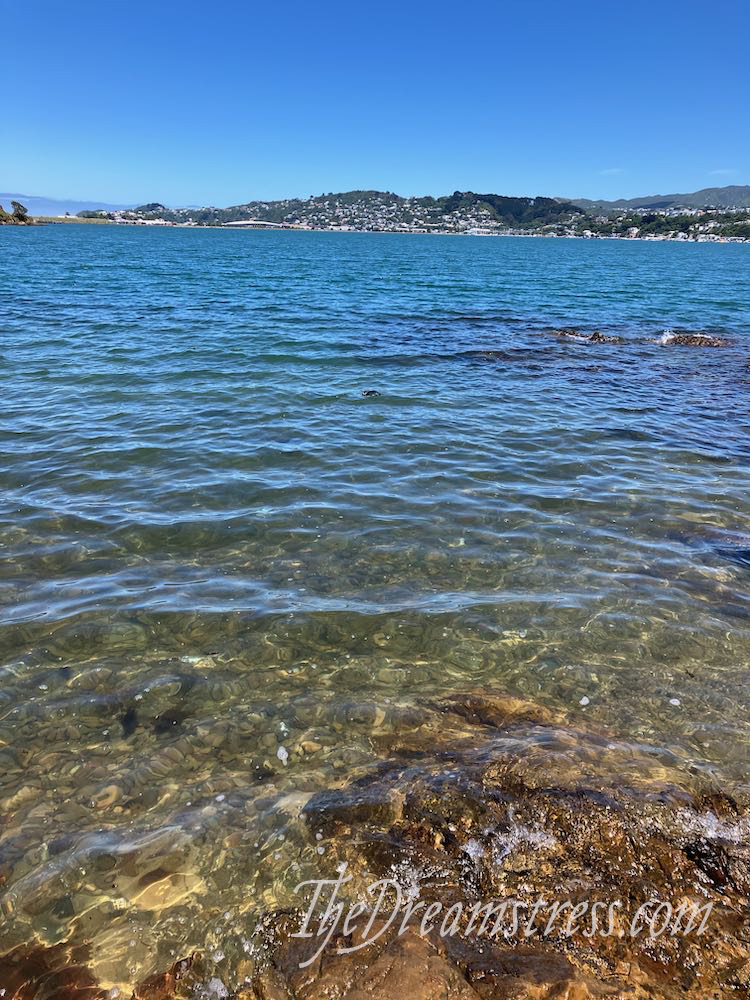
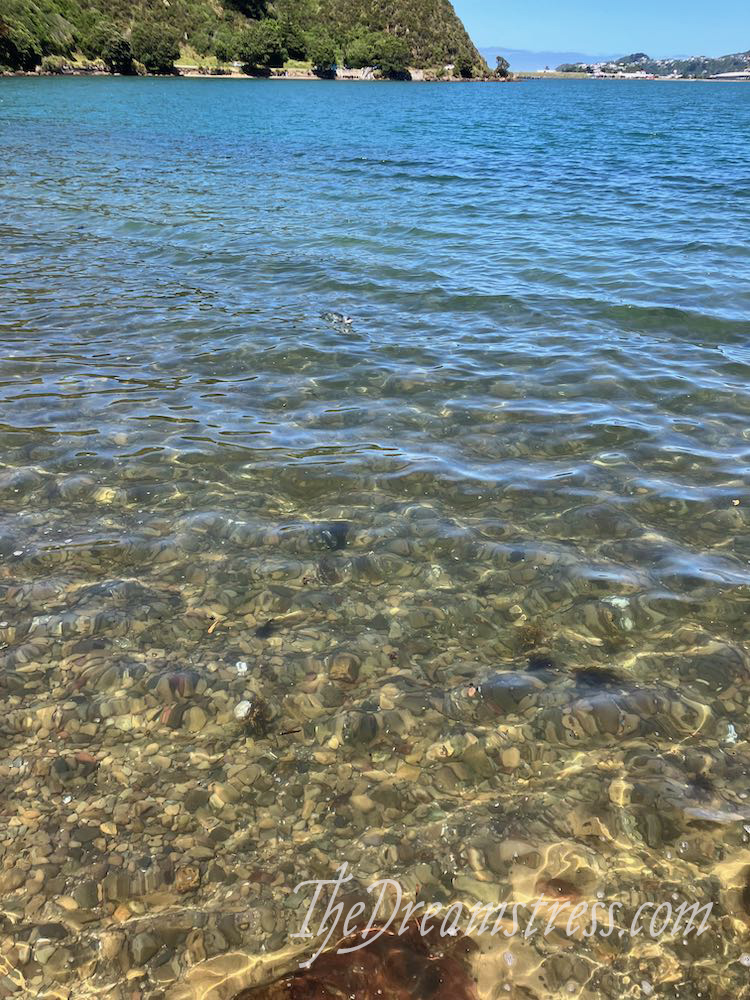
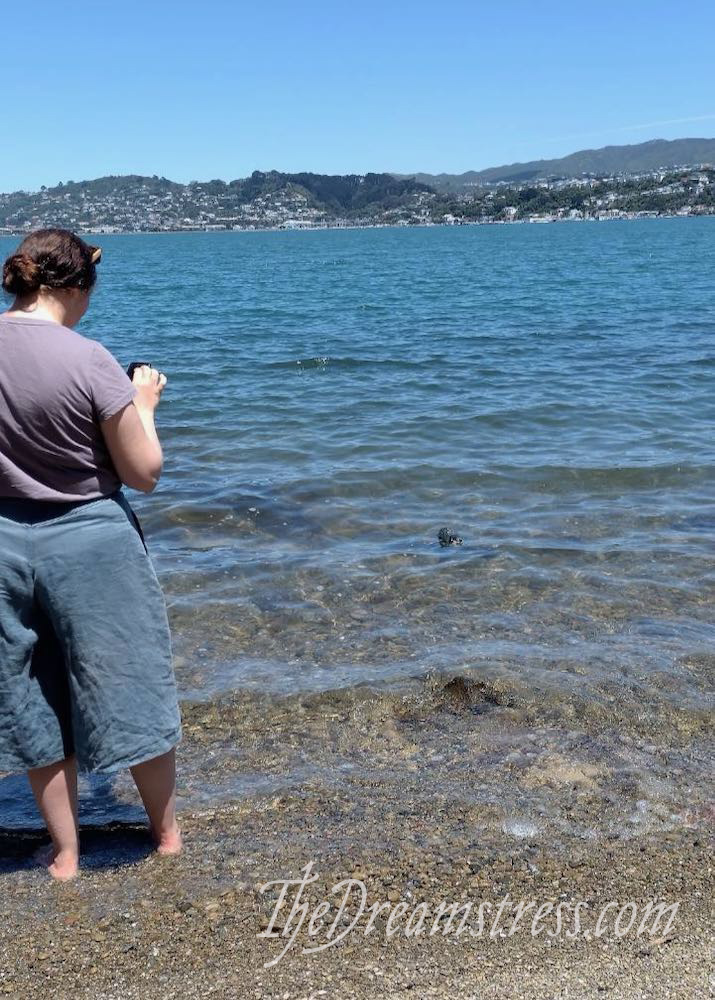
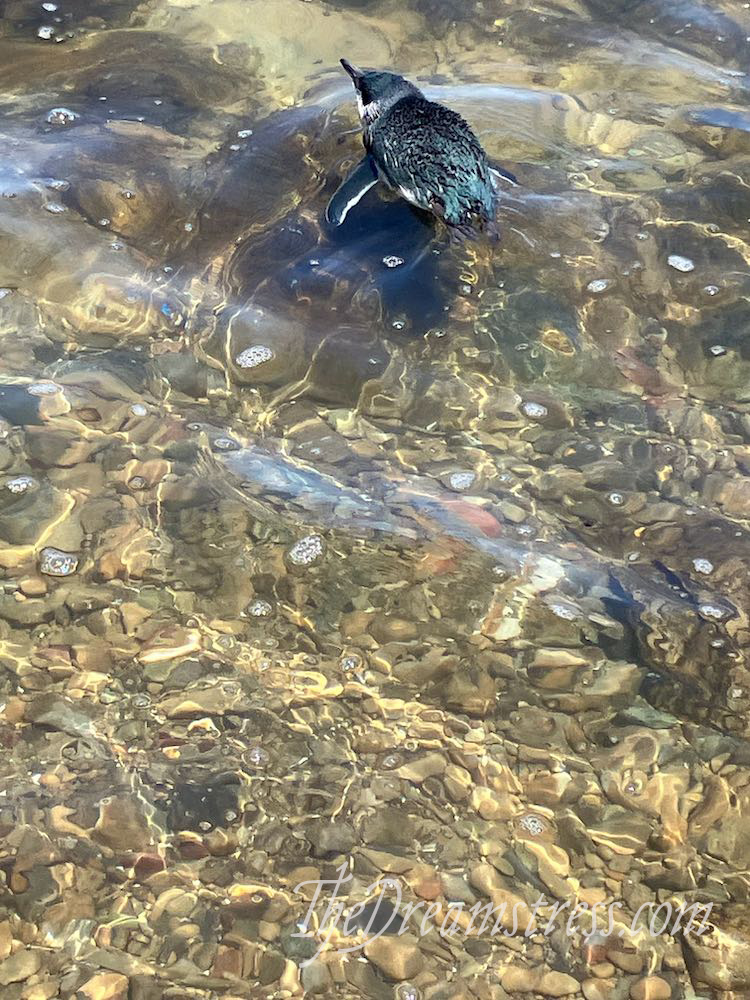


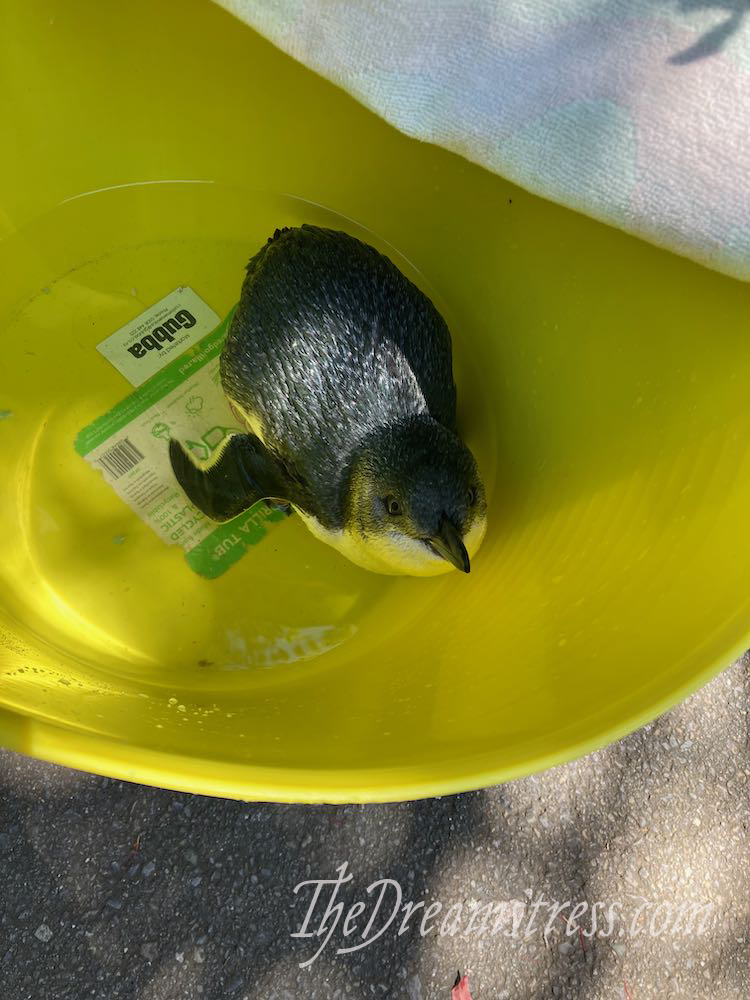
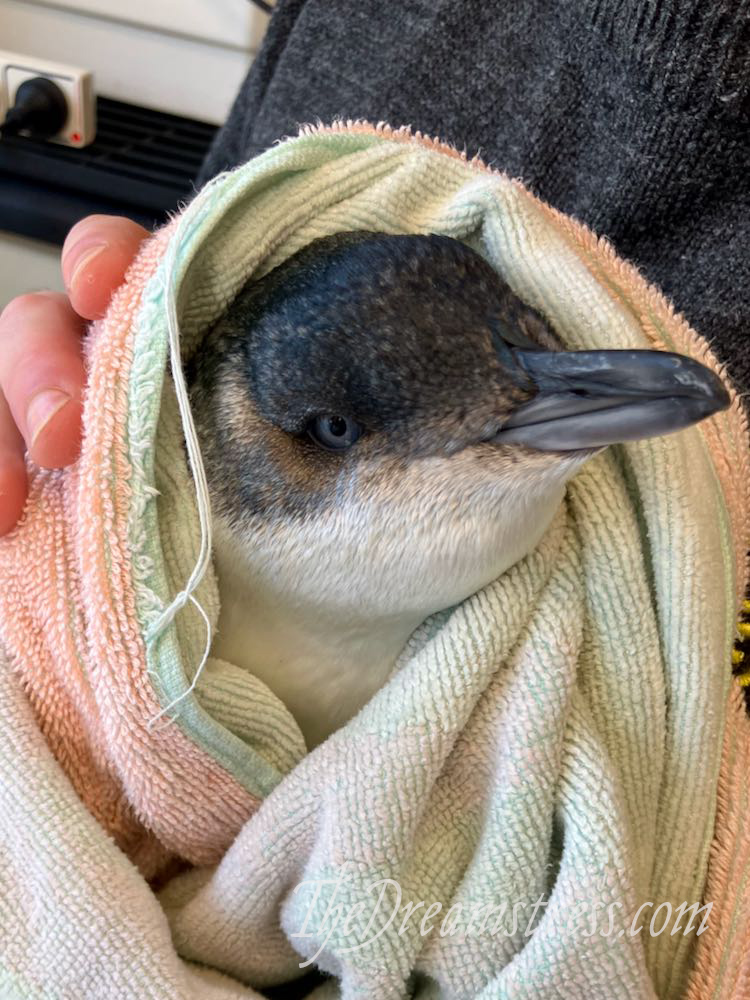








My posts on 18th century clothing in shades of purple, and the direction of stripes on 18th century sleeves, have been so popular that I thought you might enjoy a whole series on patterns and colours. You can learn so much by just looking at a bunch of images of clothes from any given era with one unifying detail.
For my first theme I picked pink.
What shades of pink were popular in the 18th century? Is there evidence those shades were more or less popular in certain decades, or mostly used on one type of garment?
Even if there are no clear trends, looking at all of the extant pinks and depictions of pinks is helpful for recreating garments and accessories using colours and patterns that look authentic. And who doesn’t love a bunch of pretty, pretty pinks?
As I began assembling images I realised two things almost immediately. First, almost every shade of pink possible shows up in extant 18th century garments and portraits. (yes, even hot pink!). Second, pink was far, far more common in 18th century clothing than purples was. Was it cheaper and easier to dye? Or, conversely, more expensive and thus more of a status symbol? Or were pink shades simply more fashionable throughout the century?
Because pink was so much more common, I’ve broken the pink post up into decades. So now you get to enjoy four (and maybe more) weeks of 18th century pink posts!
I also got a bit clever and tried to post a painting or print of the time and then an extant item or two from the same time range in a similar shade of pink.
One shade of pink that shows up frequently across the 18th century is a soft pinky-lilac that could also arguably fit under the purple banner. It’s shown here on two elegant young girls and in a length of ‘bizarre’ silk (learn more about them here).
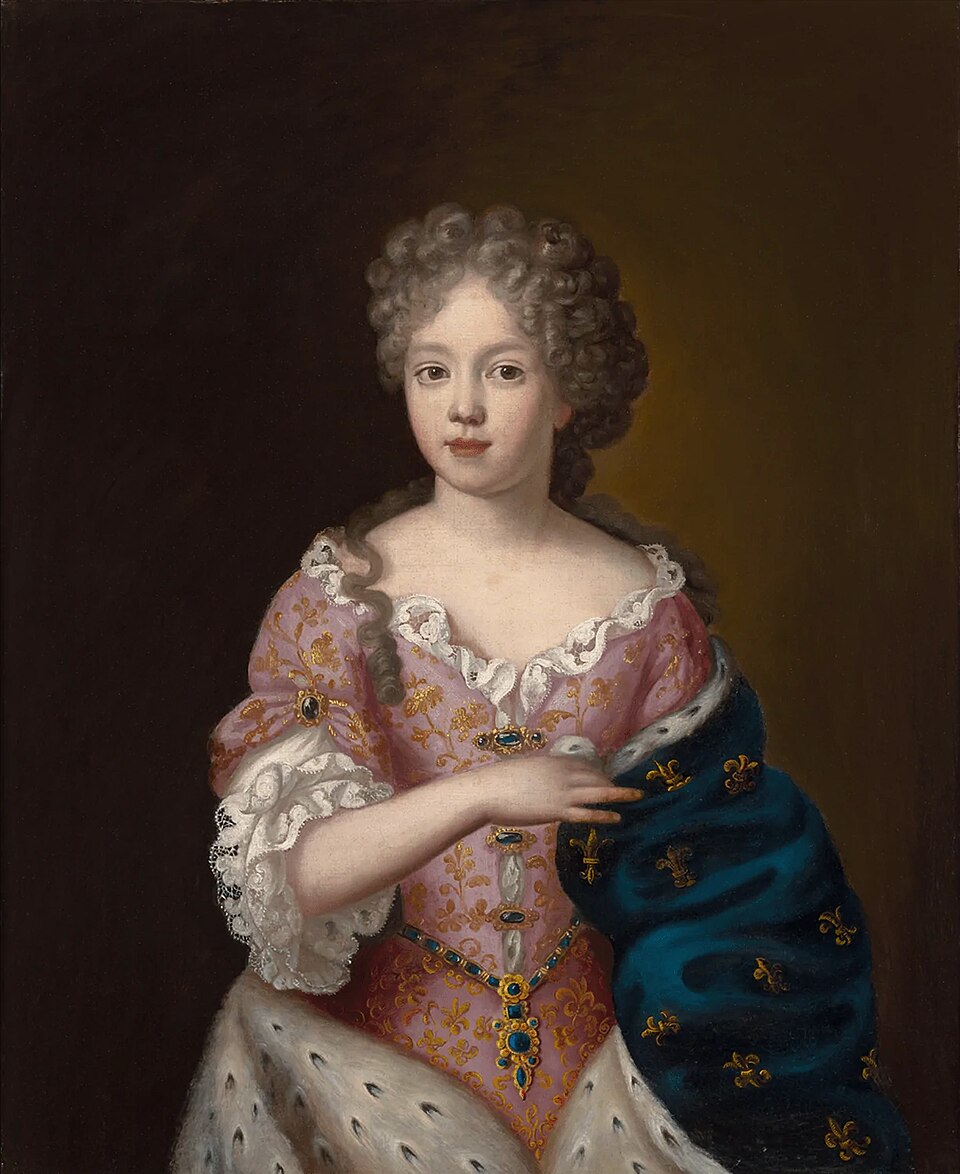
Follower of Pierre Gobert, Portrait possibly of Élisabeth Charlotte of Orléans (1676-1744), niece of Louis XIV
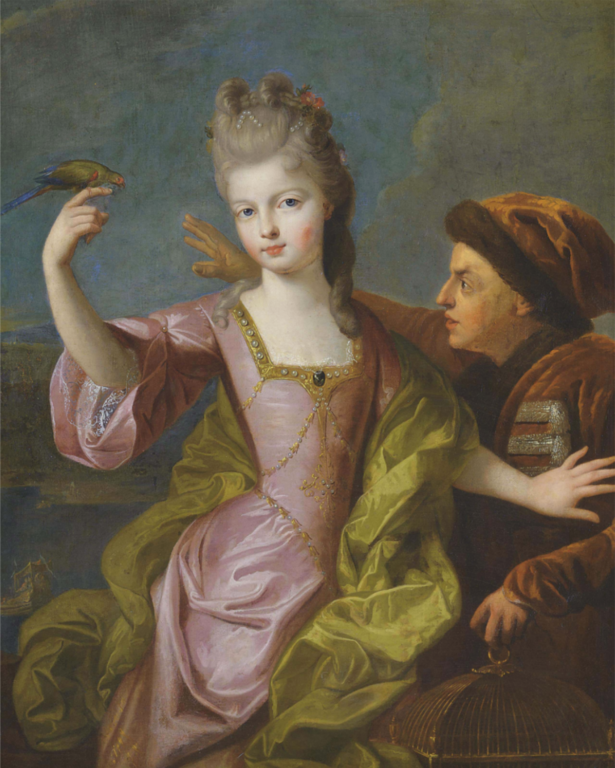
Circle of Pierre Gobert (1662–1744), Portrait of a young girl in a pink satin dress protecting her biseleur from a birdkeeper, late 17th century or early 18th century
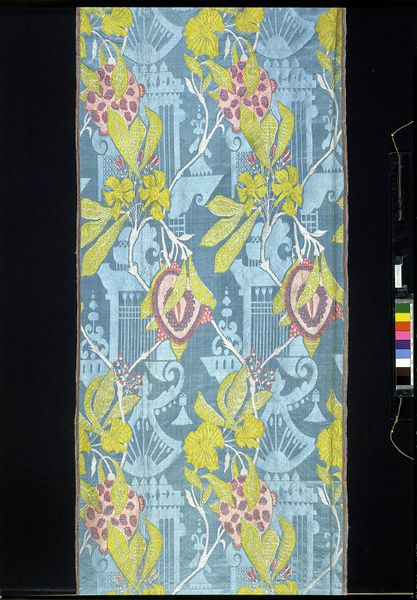
Dress fabric, Spitalfields, England, ca. 1708, Brocaded silk damask, Victoria and Albert Museum, 711-1864
I’ve cheated ever so slightly by picking a late 17th century muff to match these two young men and their snazzy pink neck ribbons. I just thought showing ribbons to go with ribbons was too good of an opportunity to pass up on.
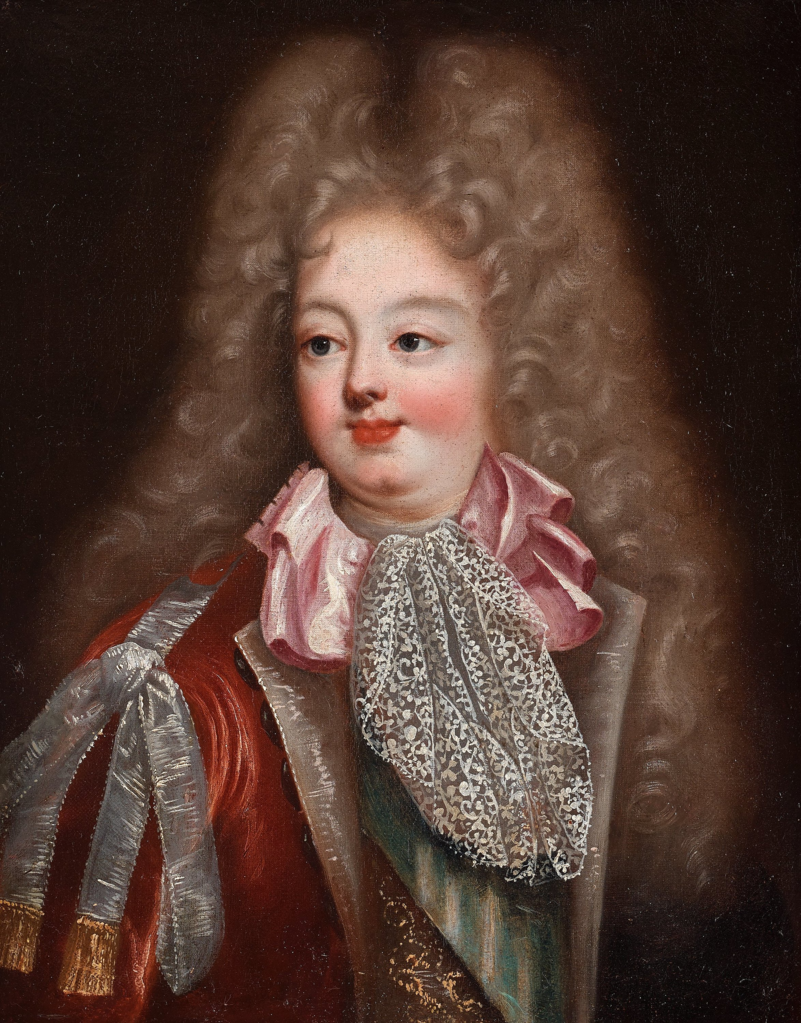
After Pierre Gobert – Portrait of a young gentleman ca 1700
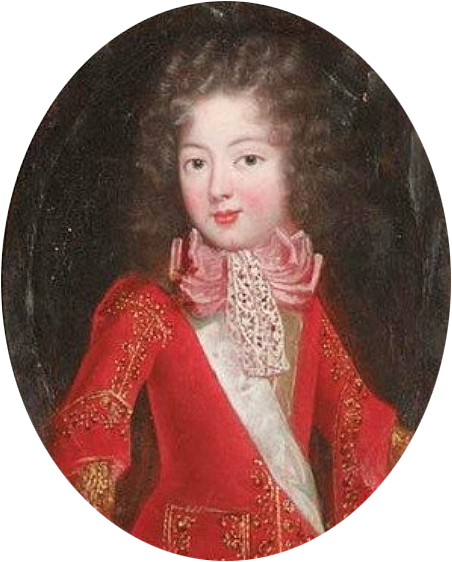
After Pierre Gobert – Portrait of a young gentleman ca 1700
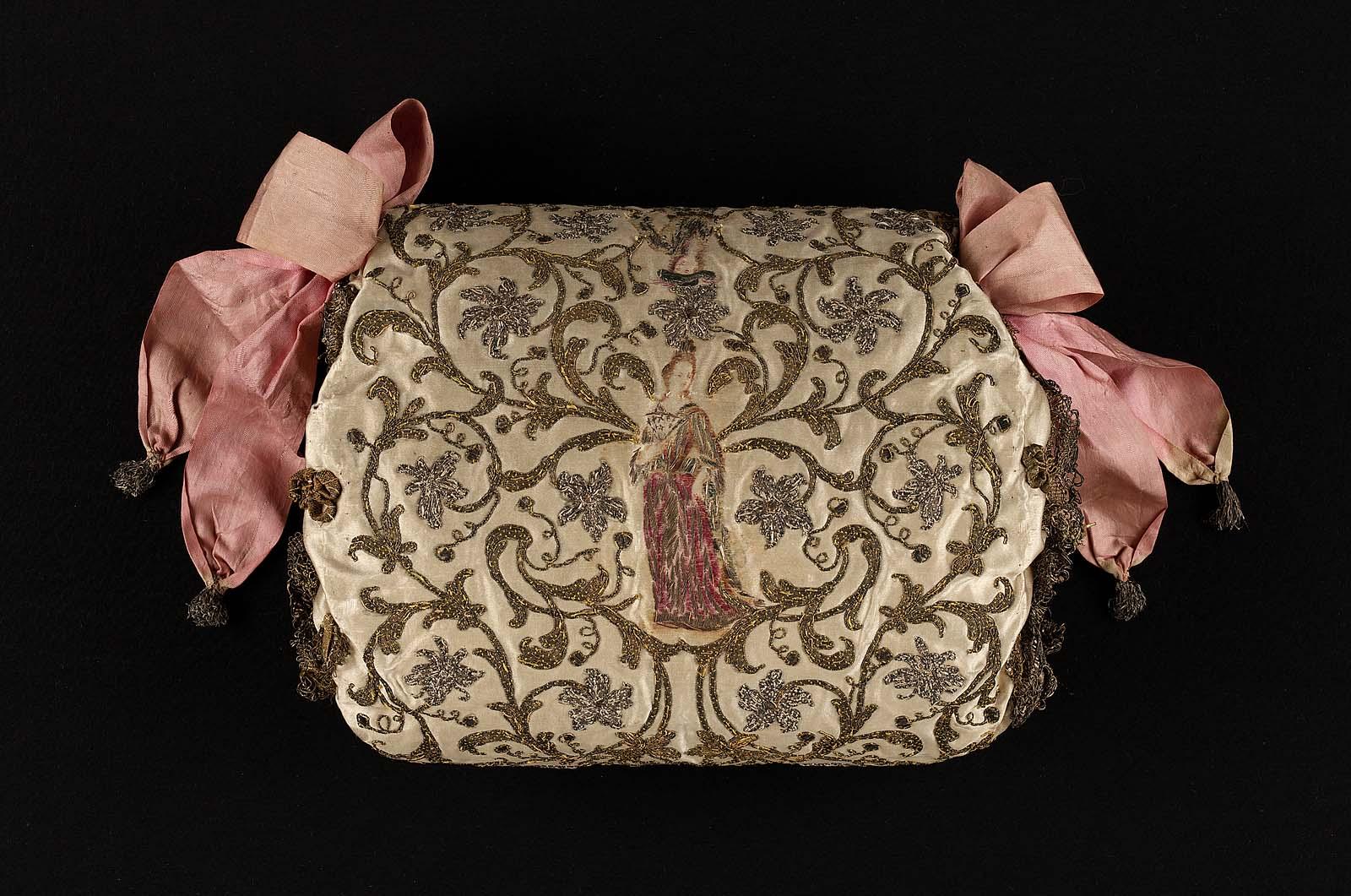
Muff French about 1680–90, France, MFA Boston 38.1266
And heres a slightly less faded pink in the same family:
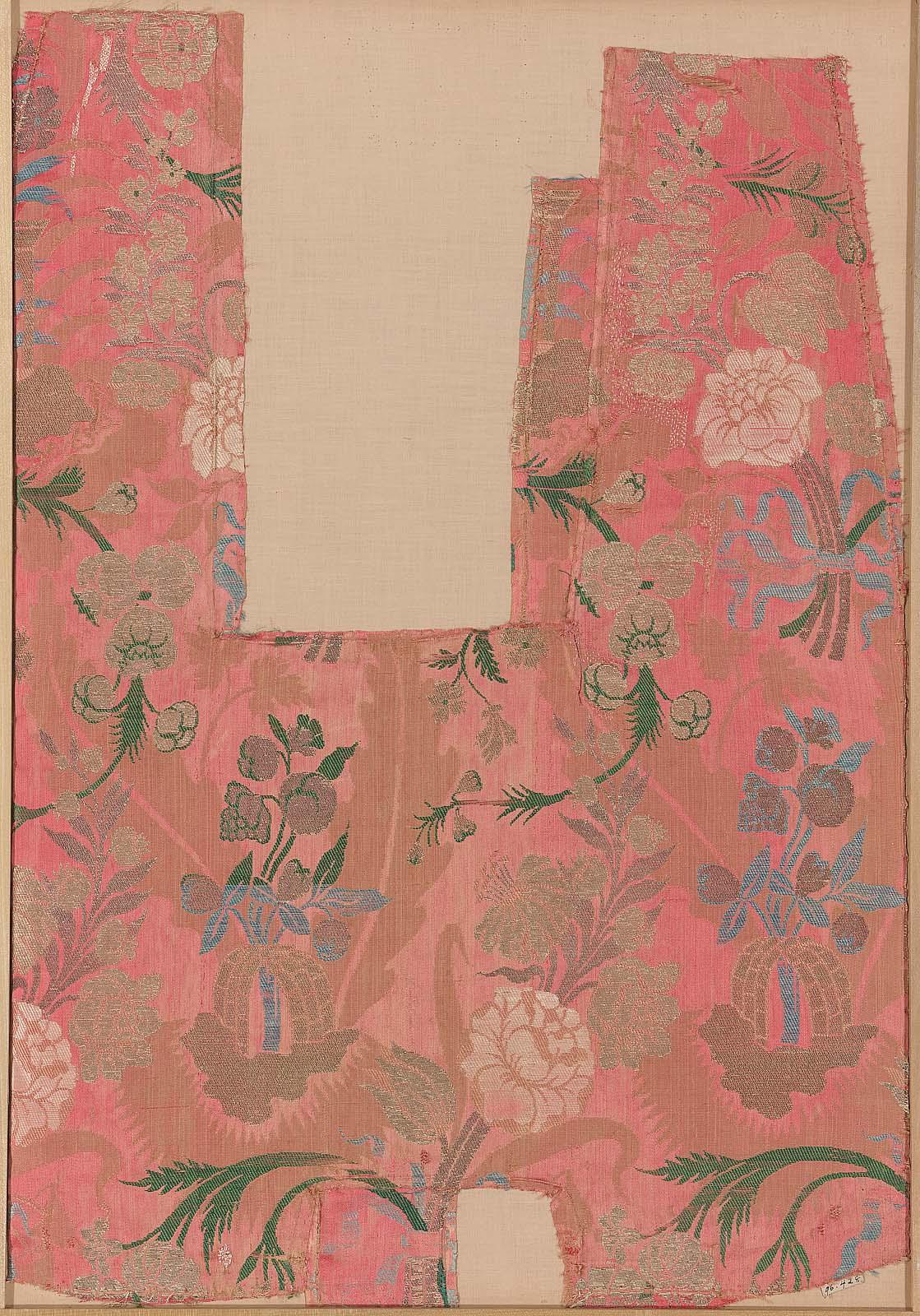
Brocaded silk, early 18th century, Continental Europe, MFA Boston 96.428
Here’s a deep rose hue:
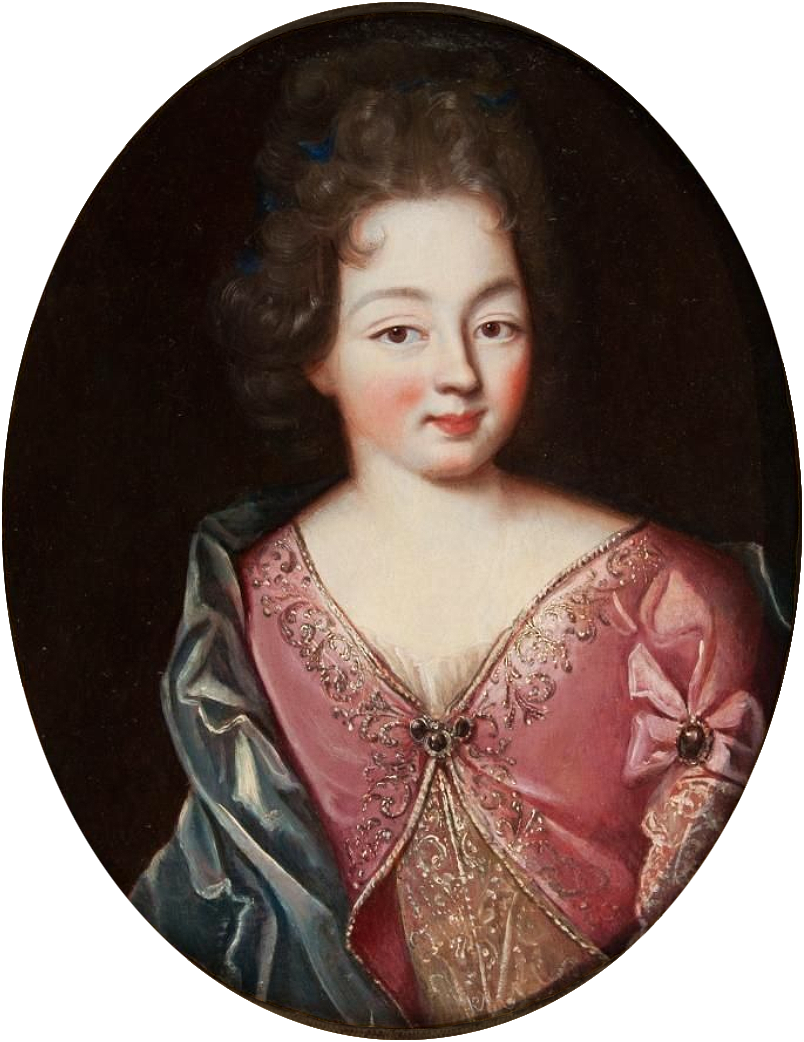
Circle of Pierre Gobert (1662–1744, Portrait of a young noblewoman, turn of the 17/18th century
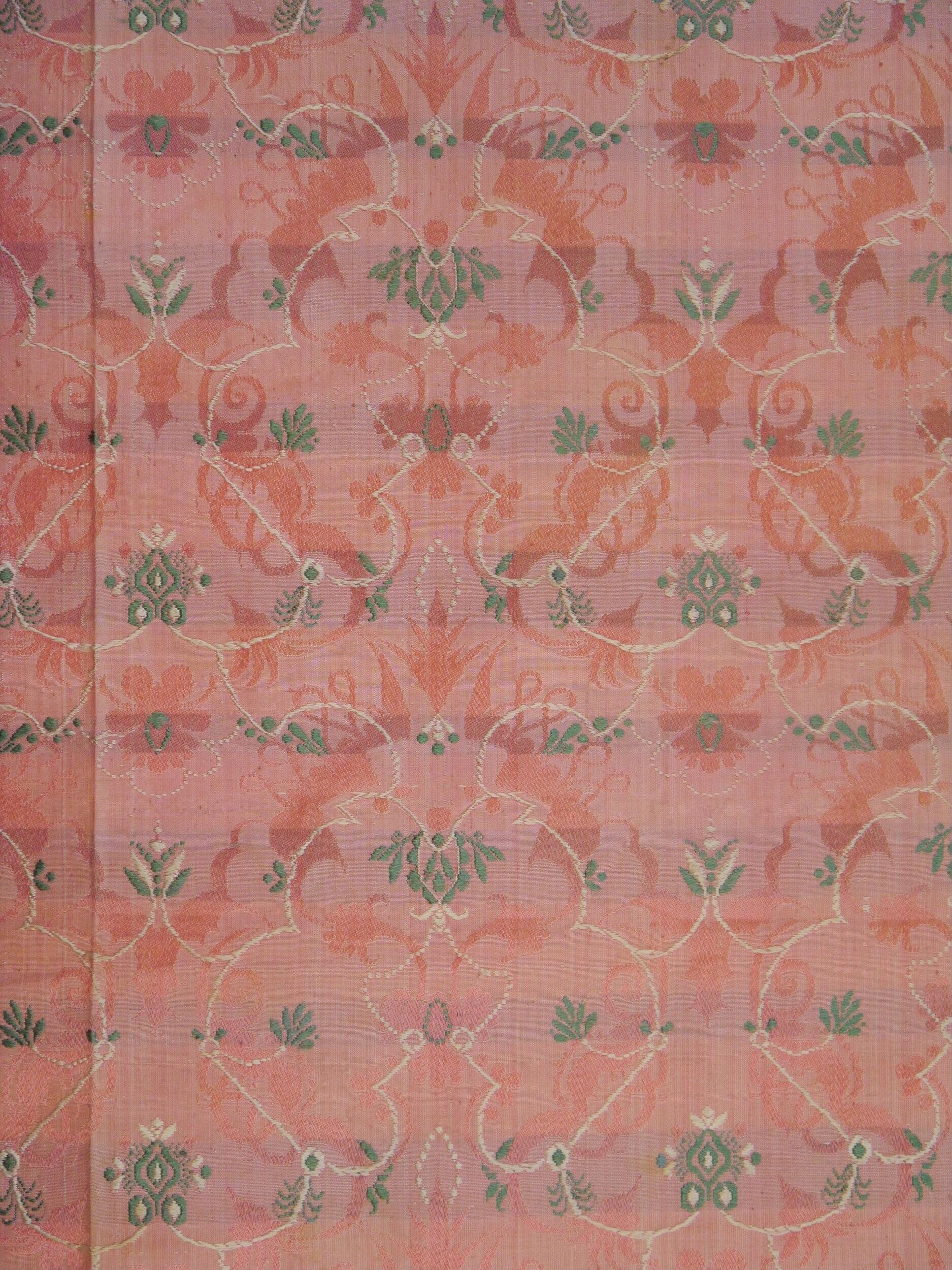
Woven silk, damask lancé with the liseré effects of the ground weft, 1675-1700, French or Italian; proto-bizarre; green and white selvedge Victoria and Albert Museum
And a beauty in blush pink with carmine ribbons in her hair
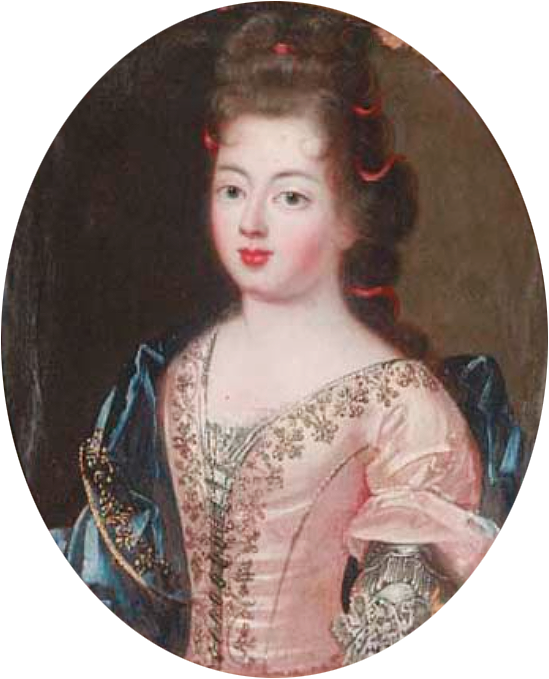
Follower of Pierre Gobert (1662–1744), Presumed portrait of Marie Louise Élisabeth d’Orléans (1695-1719), daughter of Philippe, Duke of Orléans. ca 1705
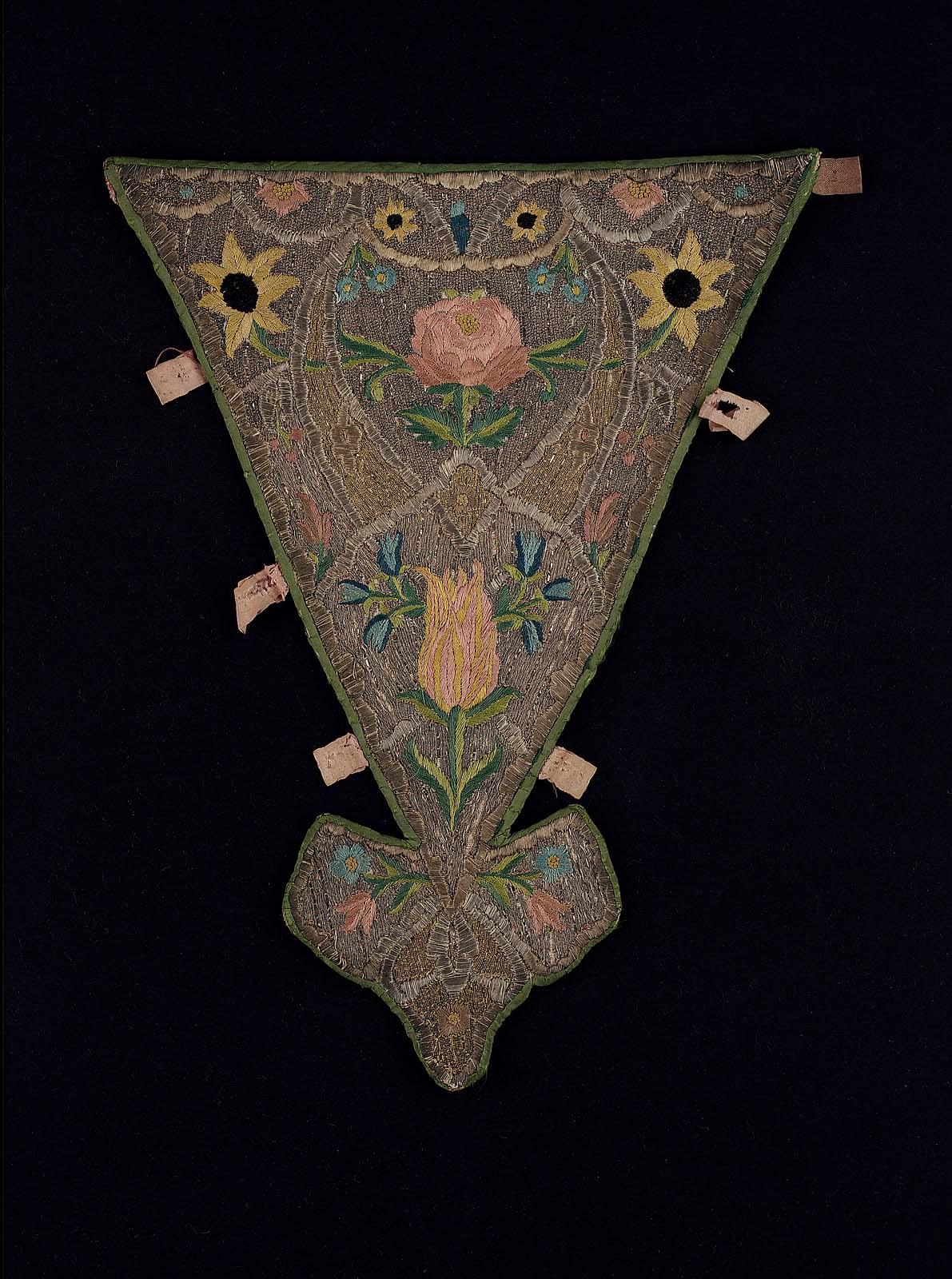
Stomacher, 1700–20, MFA Boston, 43.1909
Orange-y salmon pink is another shade that turns up in many portraits and extant textiles.

Attributed to Pierre Gobert (1662–1744), Lady in Pink, ca 1700
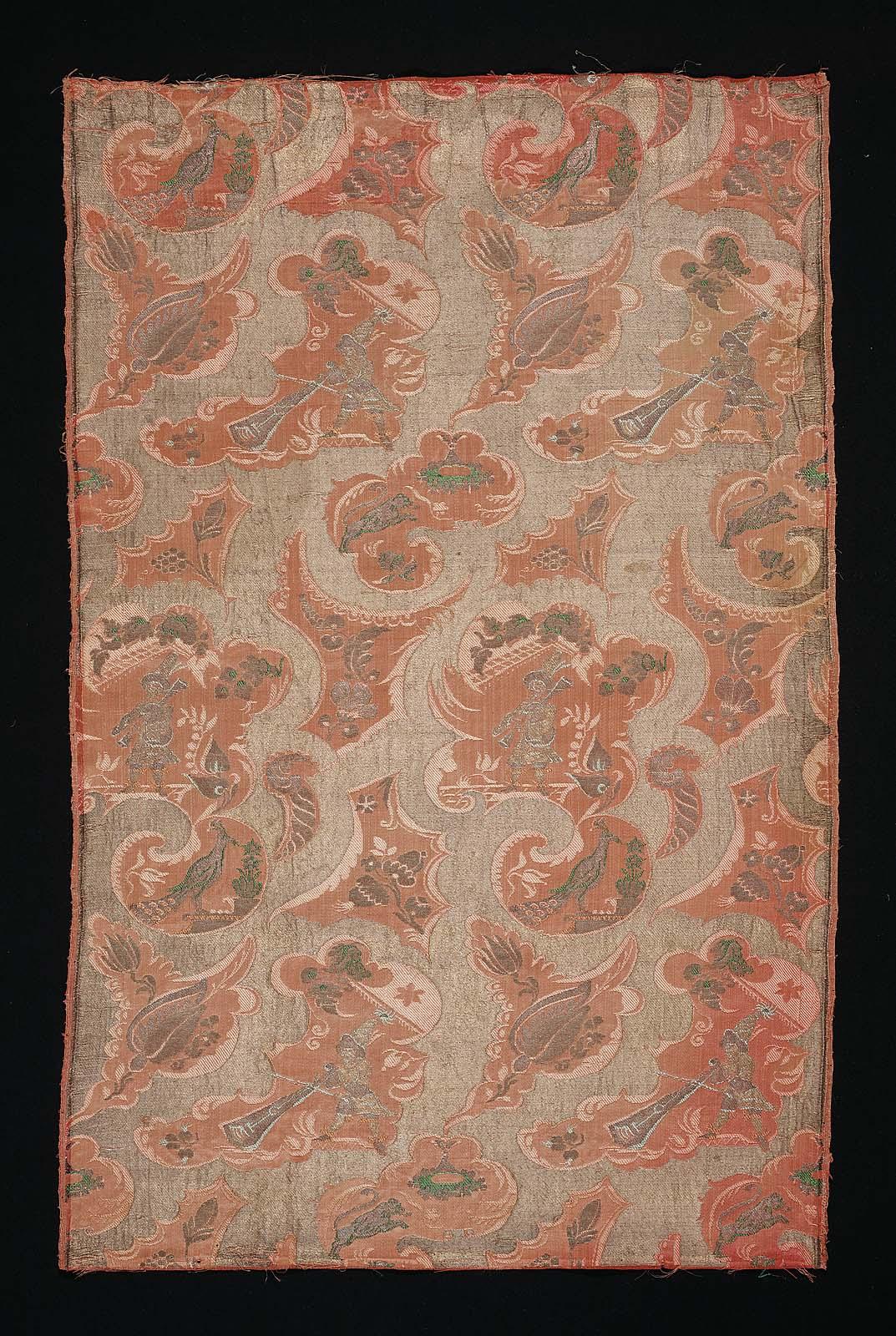
Length of brocaded silk, 1700, France, MFA Boston, 48.1168A
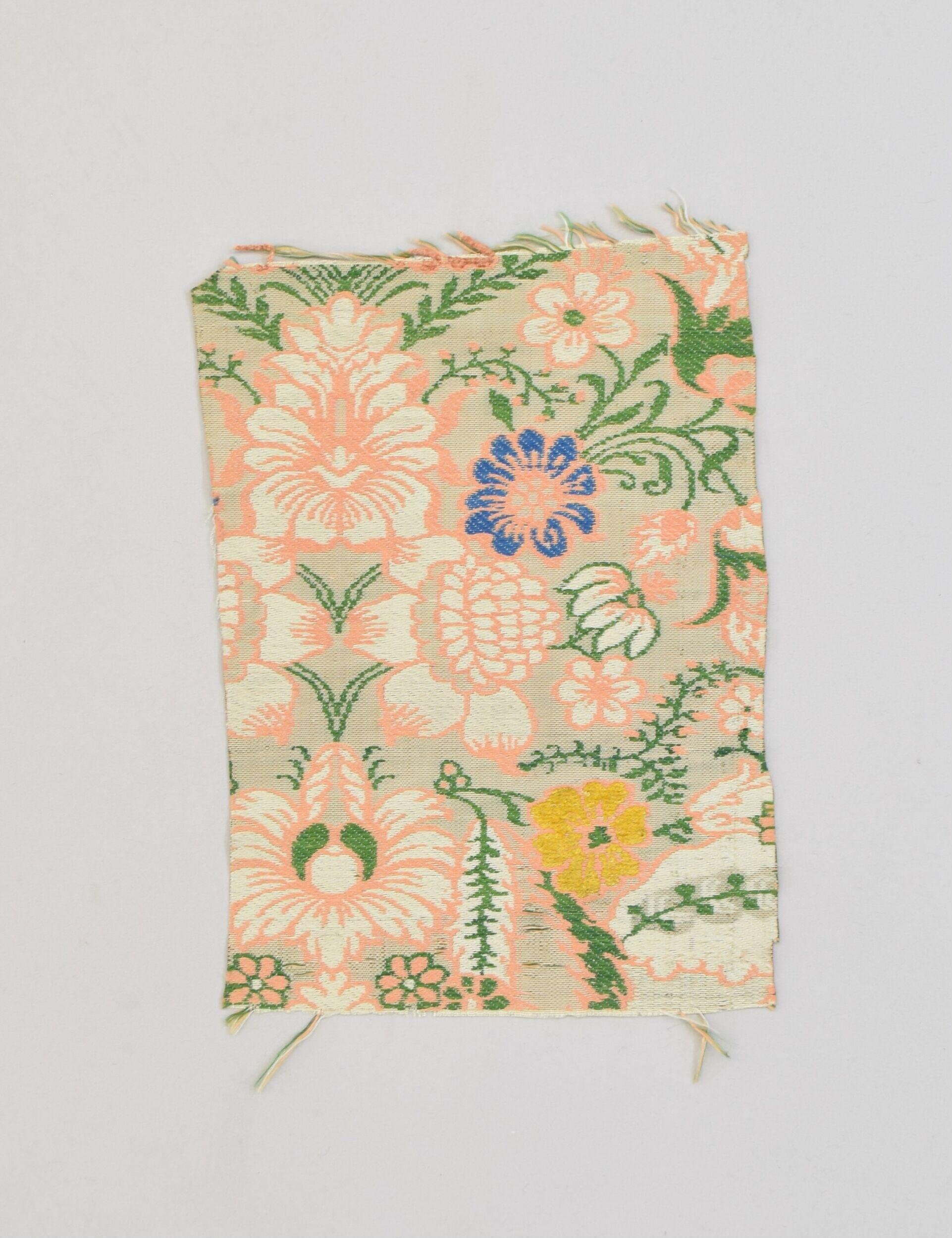
Woven silk, 1695-1710, French, Victoria and Albert Museum
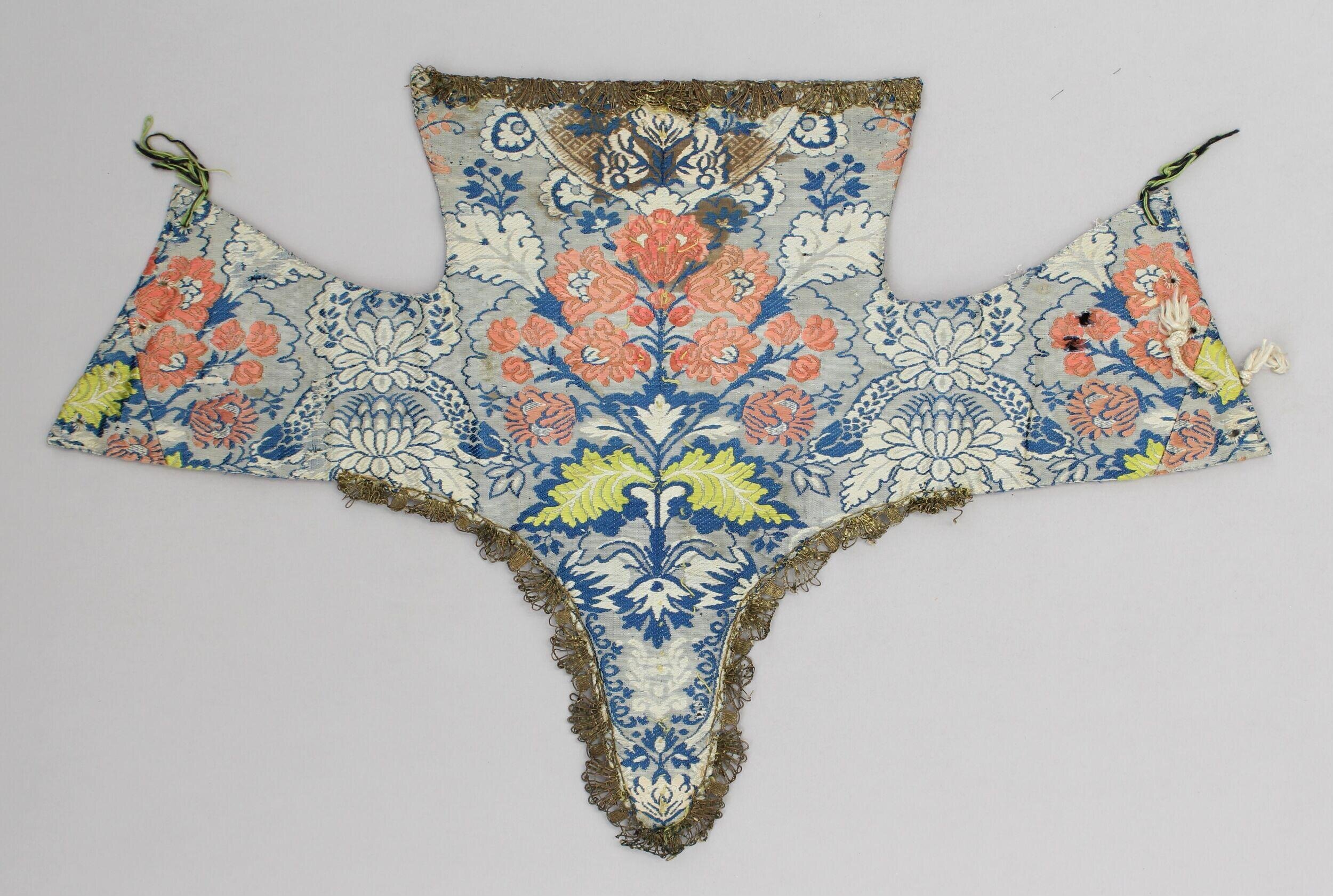
Stomacher (probably from an image robe) 1690-1710, French ? silk woven with a floral pattern, Victoria and Albert Museum
Vivid salmon pinks show up in these three paintings and a length of dress fabric, showing the same shade across four countries.
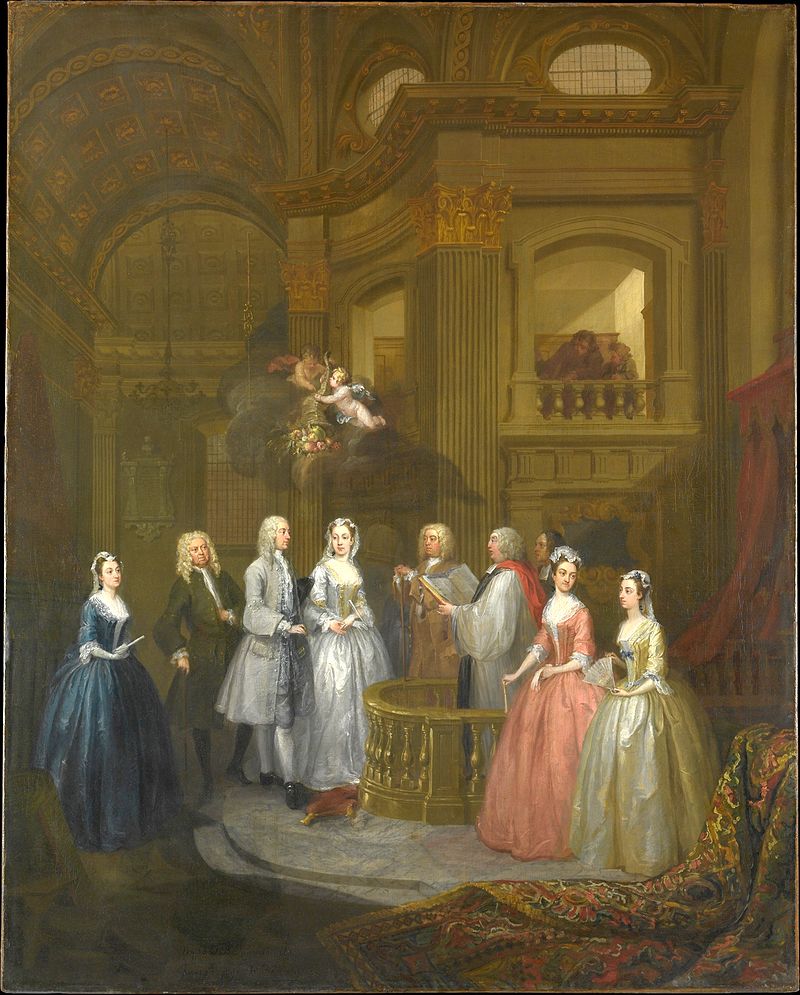
The Wedding of Stephen Beckingham and Mary Cox, William Hogarth, 1729, Metropolitan Museum of Art
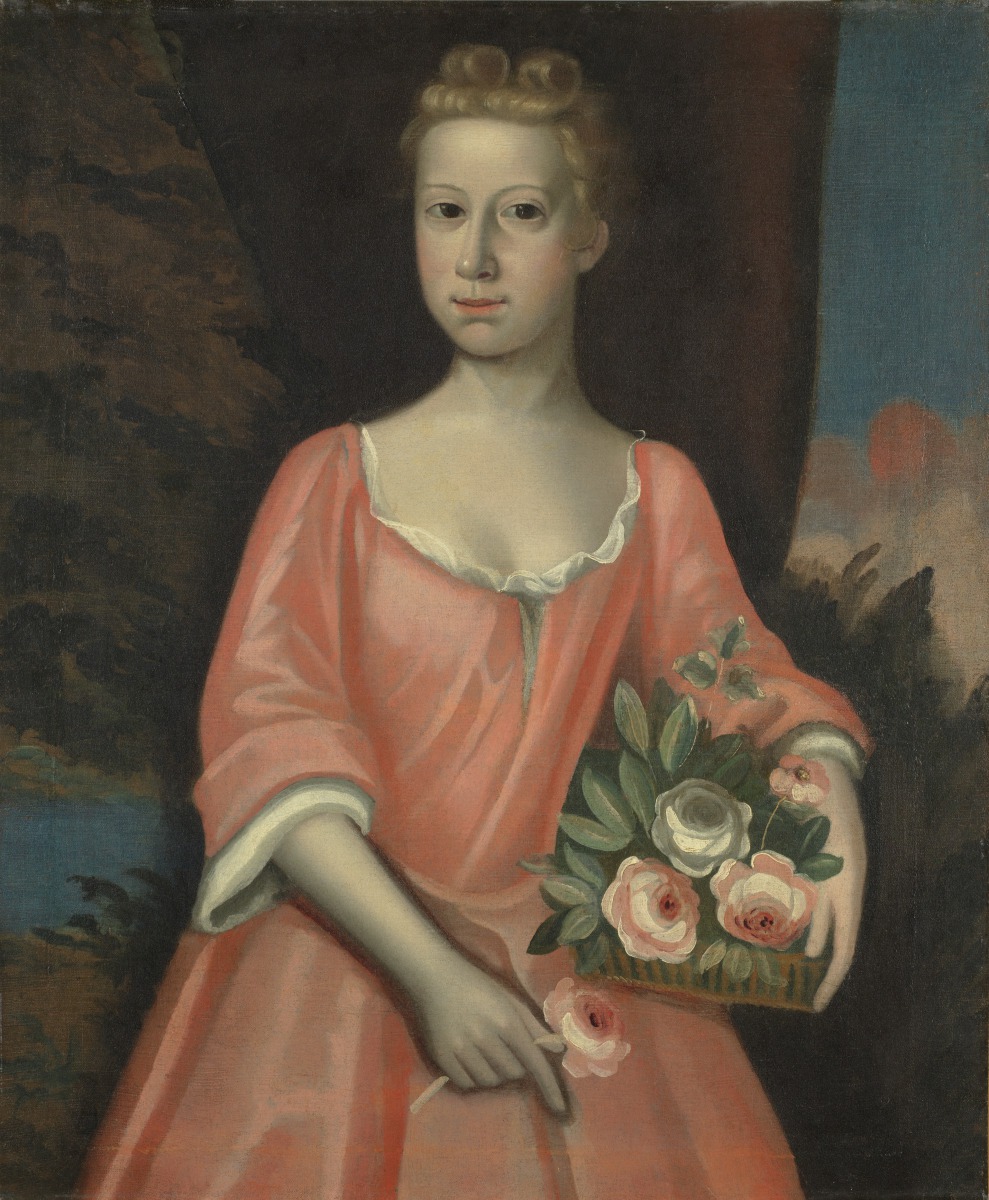
Mary Jaquelin; ca. 1722-23, Attributed to Nehemiah Partridge, American, 1683 – 1730
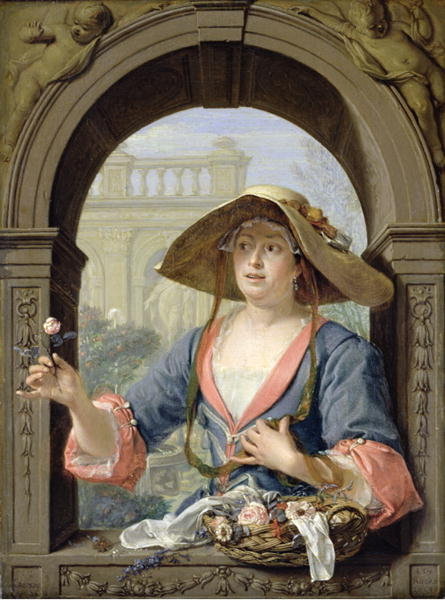
Jacques Ignatius de Roore – Portrait of M.C. Cremers, the Mistress of the Artist, 1727
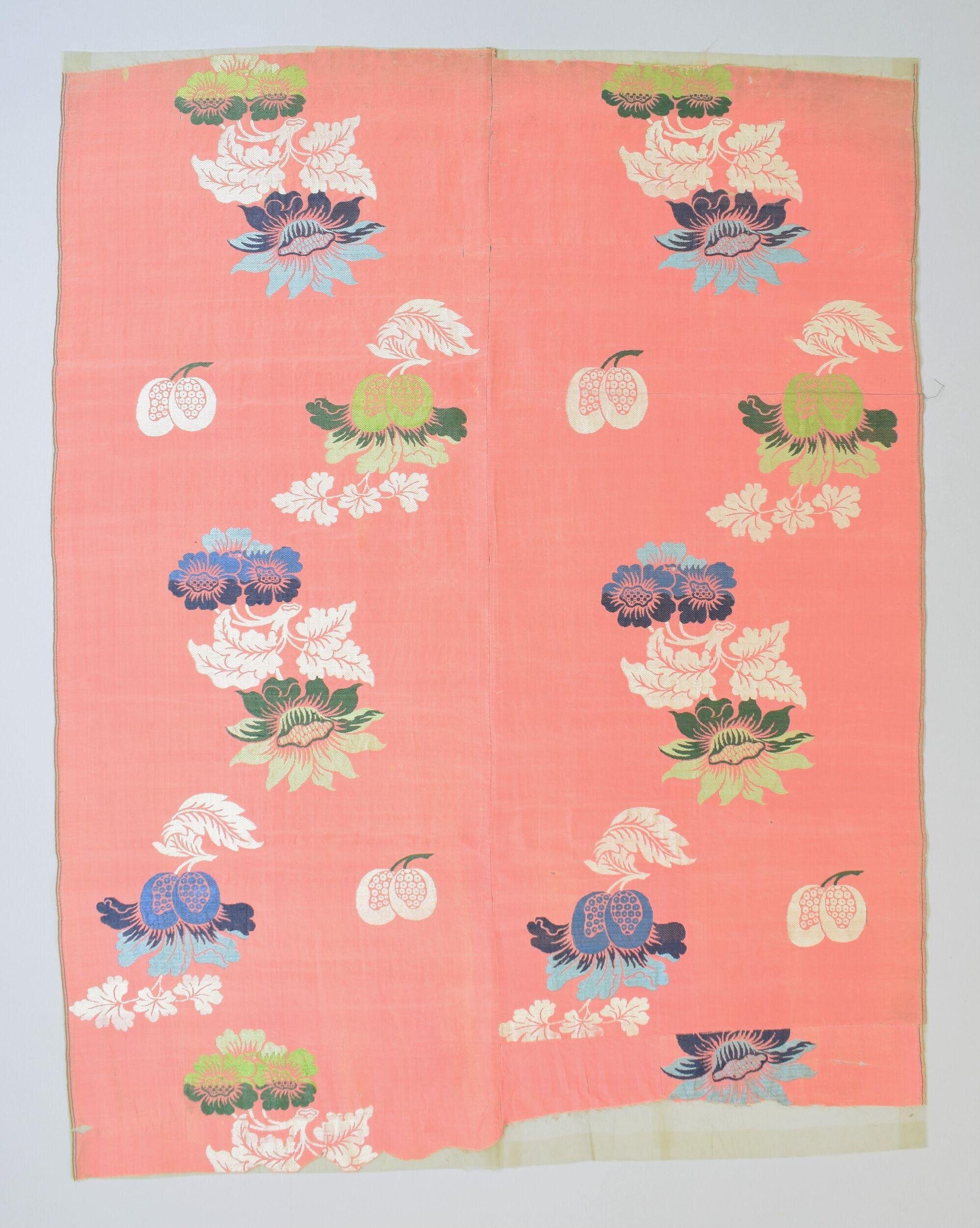
Dress fabric of brocaded silk, Netherlands, 1735-1740, Victoria and Albert Museum
A slightly softer shade is seen on Frances, Lady Byron, and a pair of very fashionable velvet shoes:
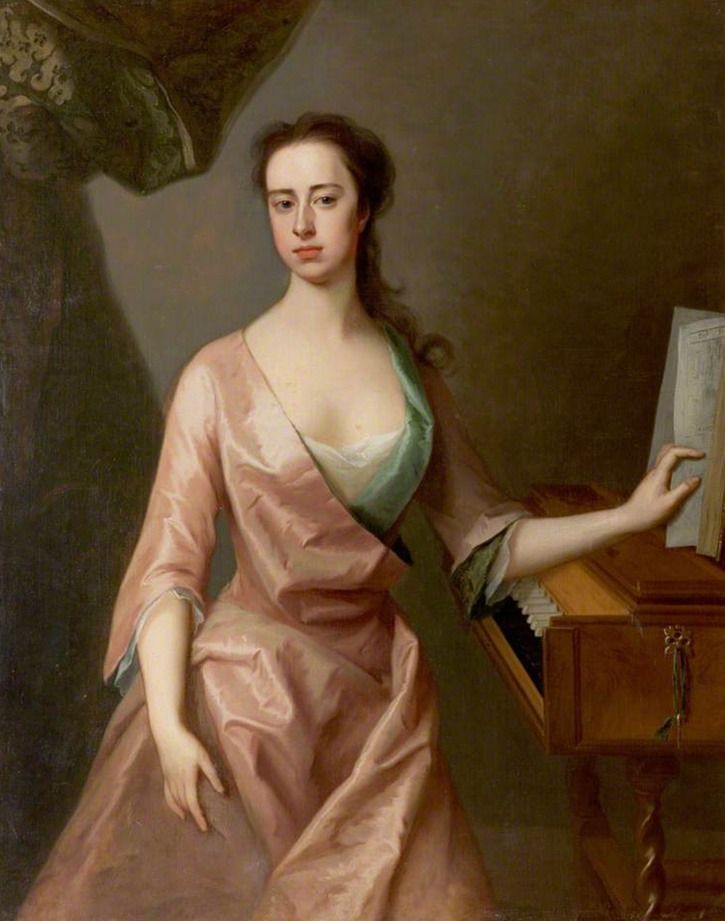
Frances, Lady Byron (d.1757), Third Wife of the 4th Lord Byron by Michael Dahl, ca. 1720
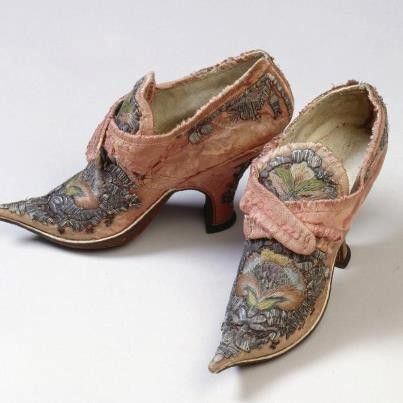
Embroidered Pink Velvet shoes, 1720s
Here’s another example of that lilac pink:
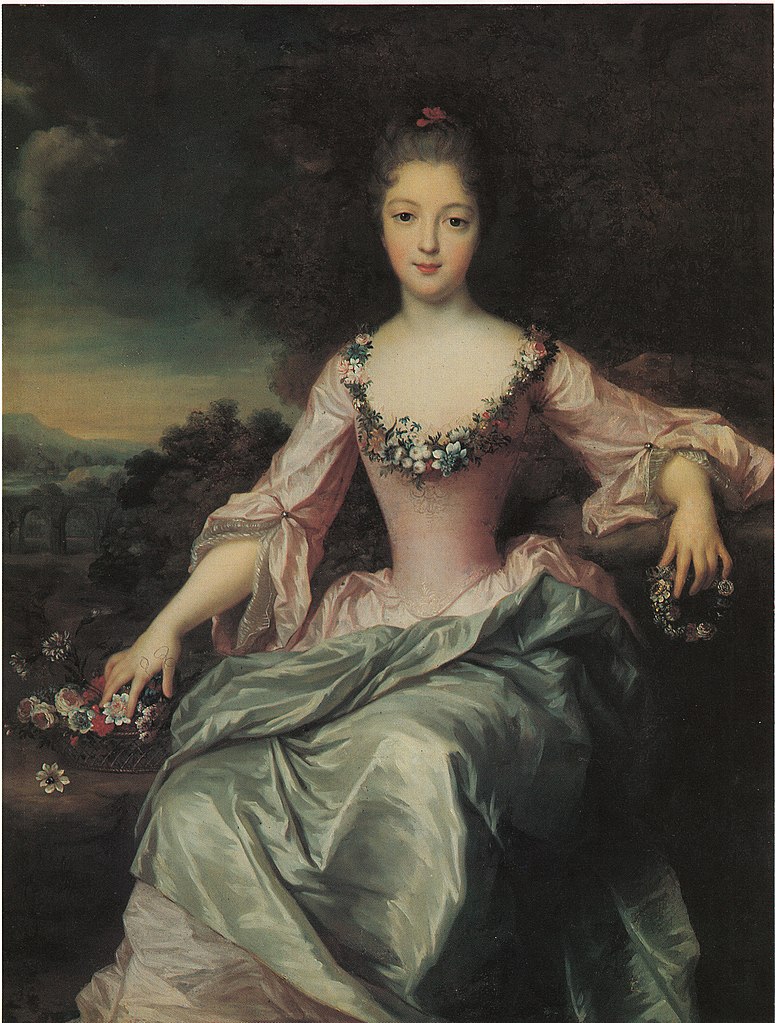
Gustaf Lundberg (1695–1786), After Jean-Baptiste Santerre (1651–1717), Portrait of Marie Anne de Bourbon, 1720
This noblewoman sports a lilac pink gown, a carmine pink robe, and a dazzling array of matching pink jewels:
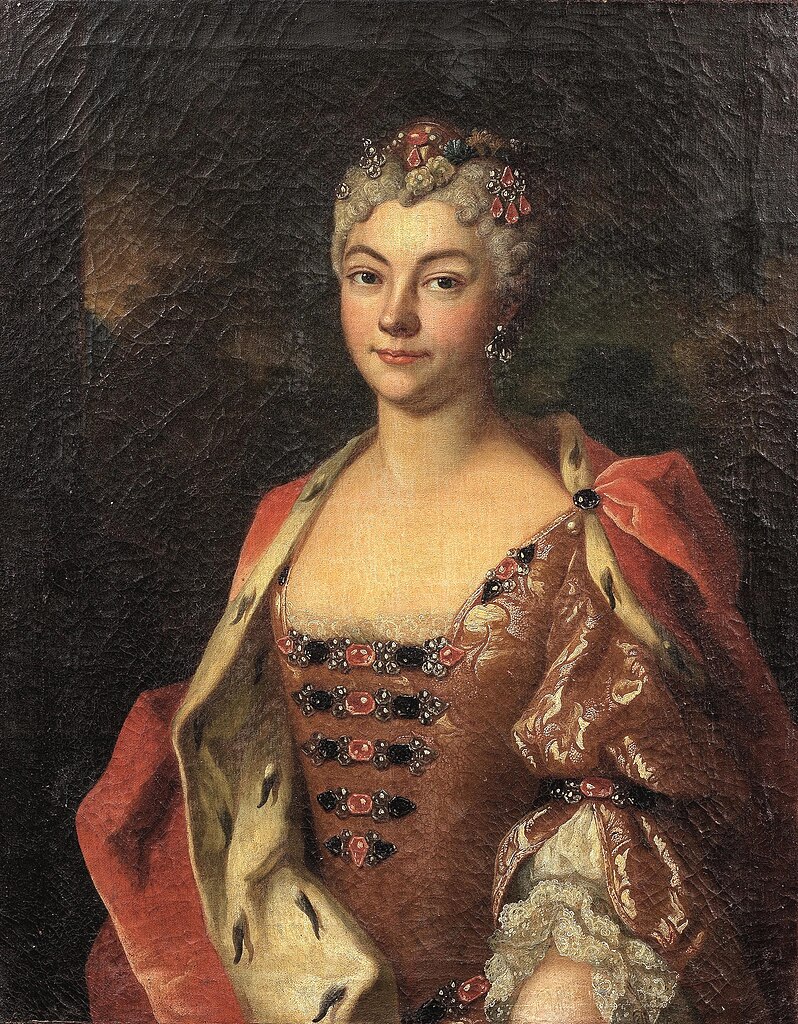
Henri Millot – Portrait of a noblewoman in a pink dress and an ermine-trimmed robe, ca. 1725
And this casaquin and petticoat features every shade shown above, and then some!
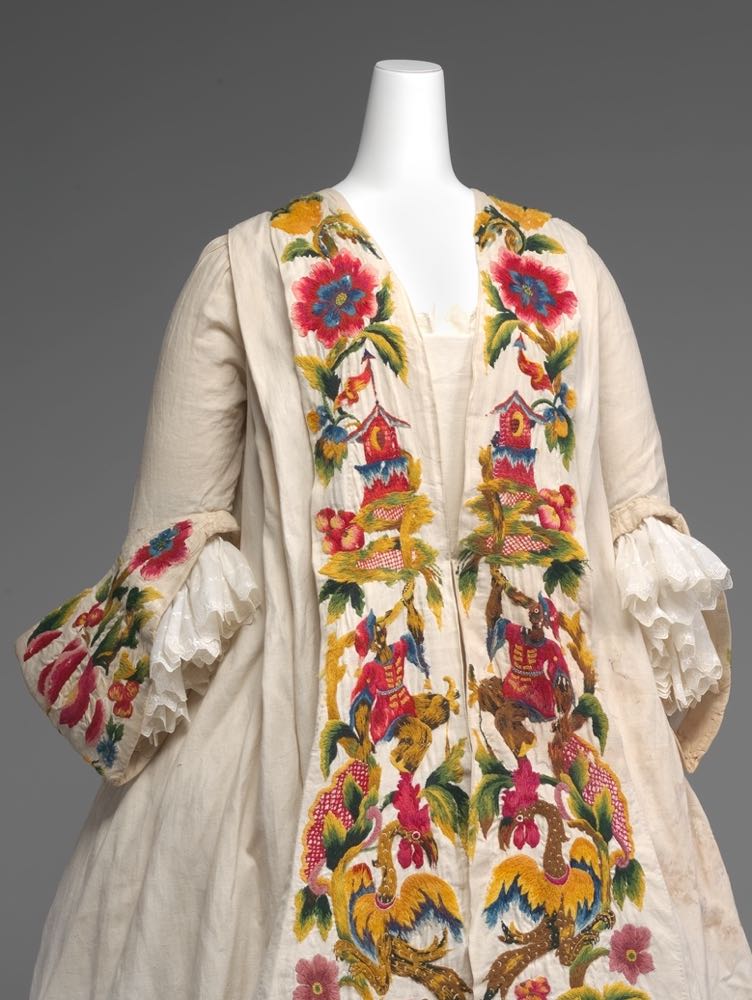
Dress (casaquin and petticoat), 1725—40, Italian, linen with wool embroidery, Metropolitan Museum of Art 1993.17a, b
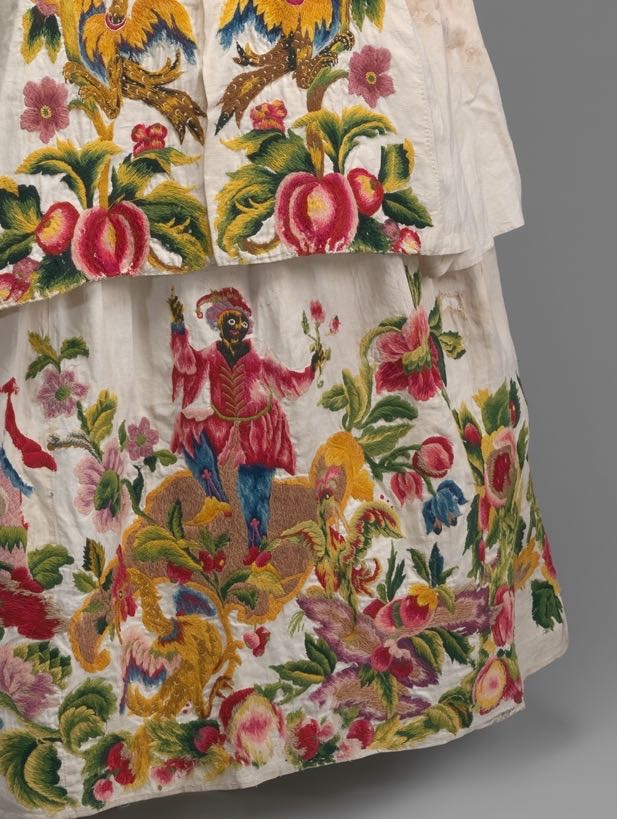
Dress, 1725—40, Italian, linen with wool embroidery, Metropolitan Museum of Art 1993.17a, b
Here’s a gloriously vivid pink:
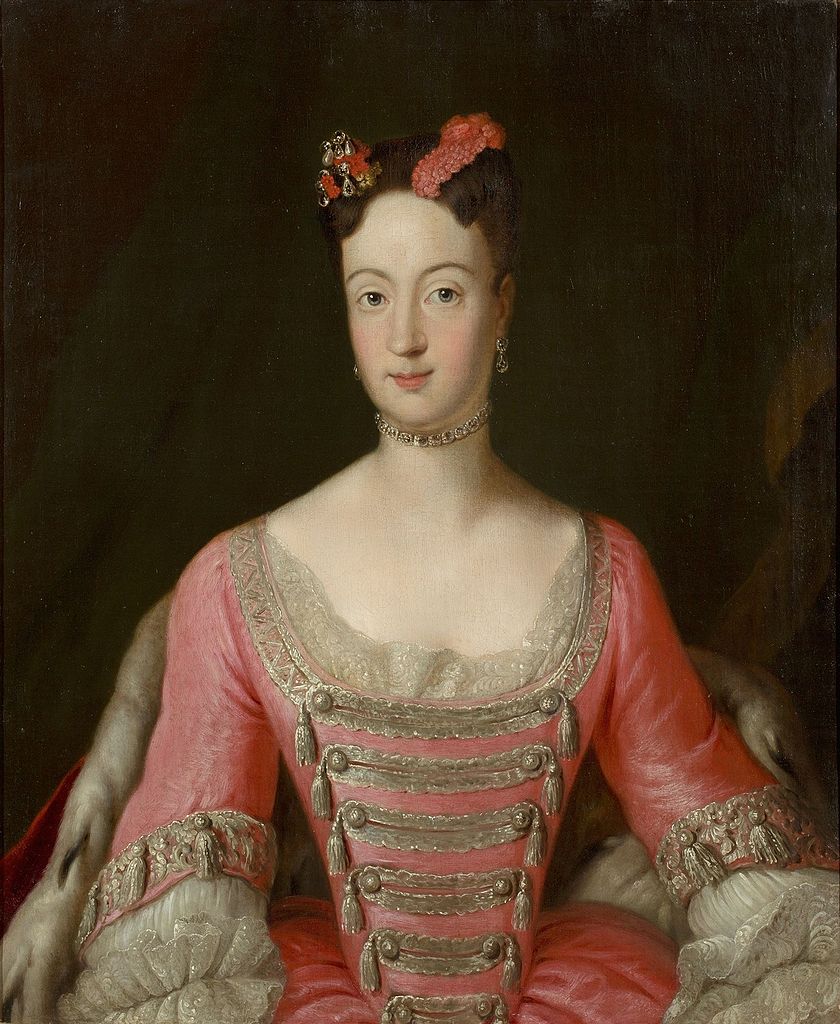
Antoine Pesne Portrait of Wilhelmine of Prussia, Margravine of Brandenburg-Bayreuth (1709-1758), 1725
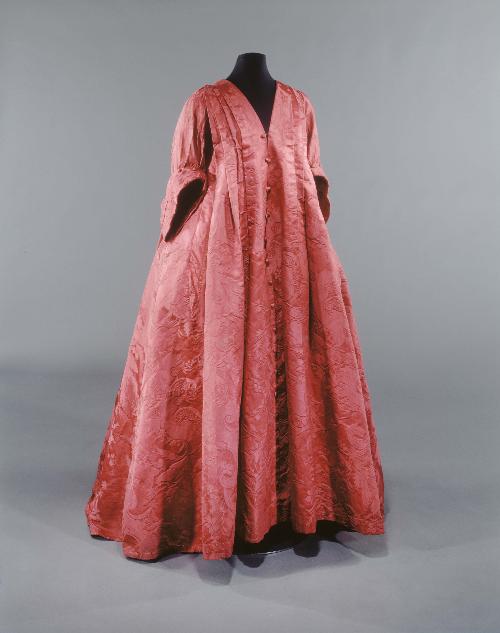
Robe Volante 1720-30, Musee Galliera
And for some pinks on men, the Ottoman ambassador to France in pale pink:
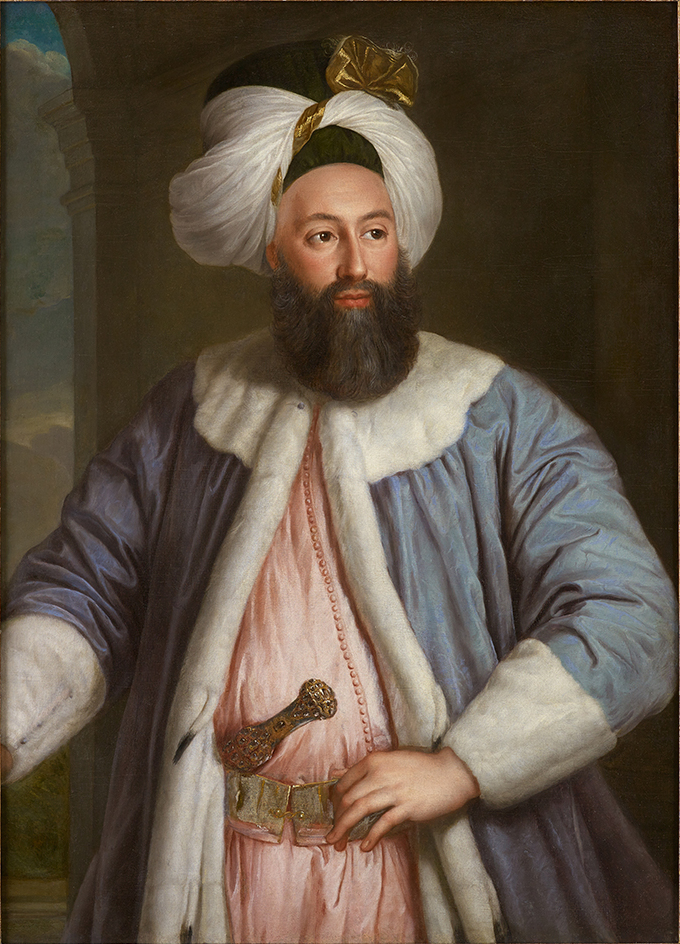
Pierre Gobert (1662–1744, Portrait of Yirmisekiz Mehmed Çelebi, commissioned by the Bâtiments du Roi. 1724
And some coral silk stockings for showing off a well-turned leg:
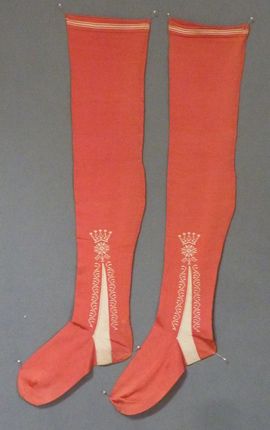
Men’s coral silk stockings, 1725-1750 meg-andrews.com
This waistcoat is the equal to the casaquin above for its demonstration of the many shades of pink available:
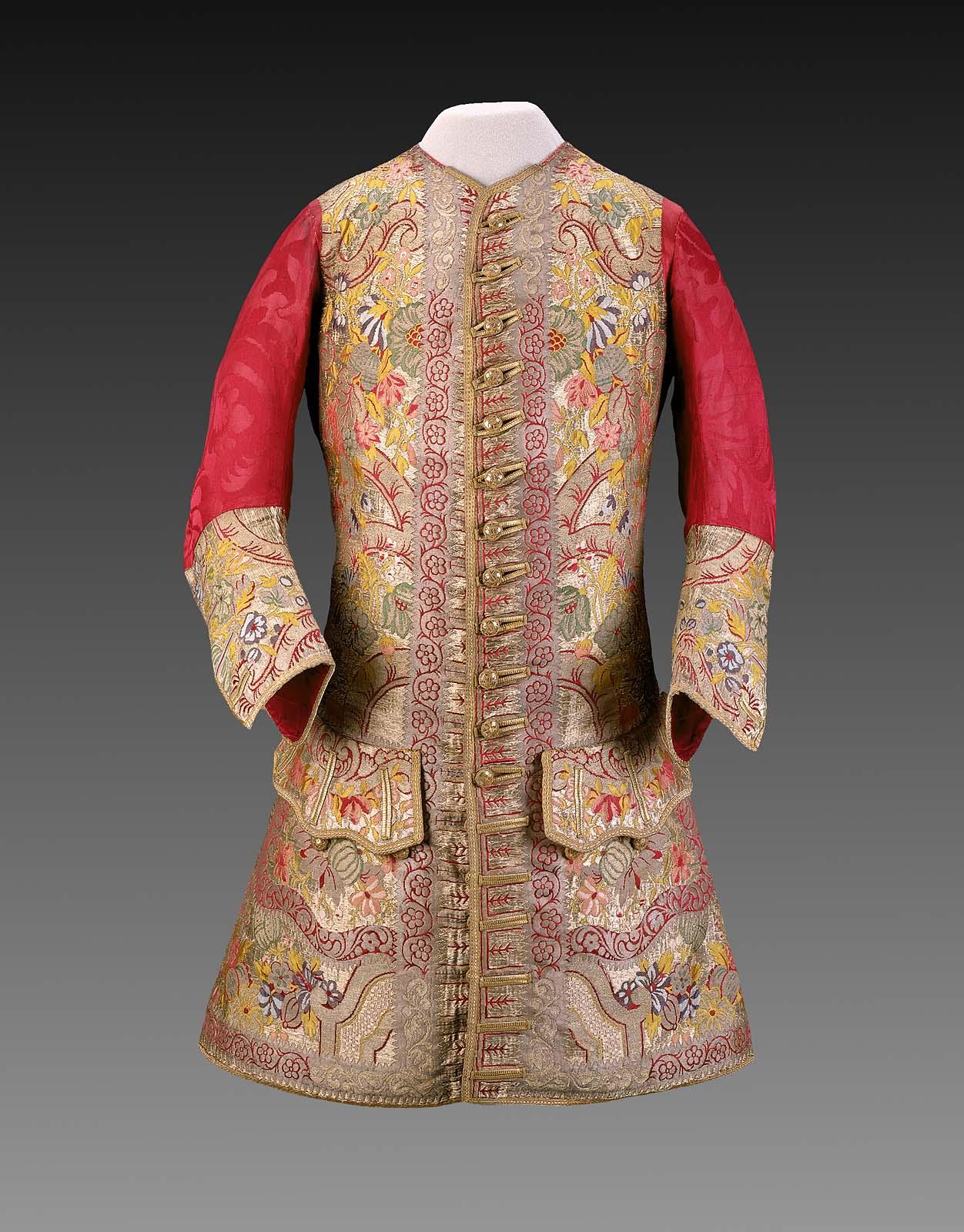
Man’s sleeved waistcoat, American (English fabric) 1720s, Silk damask, brocaded with silk and metallic yarns,, MFA Boston 41.887
Polyxena of Hesse isn’t afraid to mix colours, with a bold combination of deep rose and scarlet red:
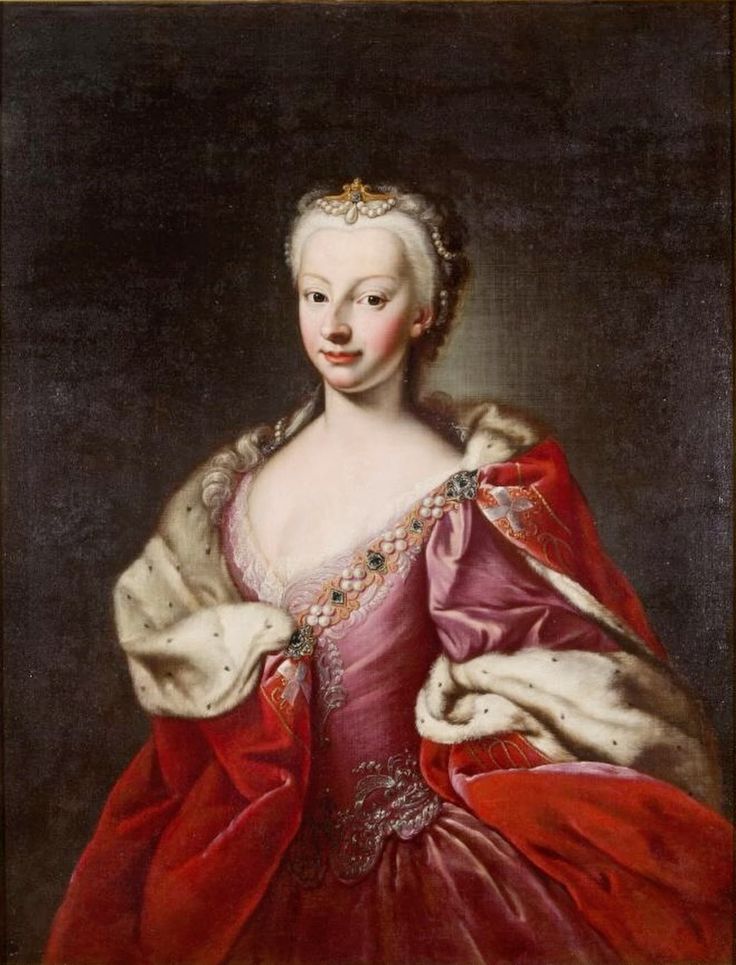
Polyxena of Hesse-Rotenburg by Maria Giovanna Clementi, 1730-35, Madrid, Museum Cerralbo.
Deep rose shoes to match:
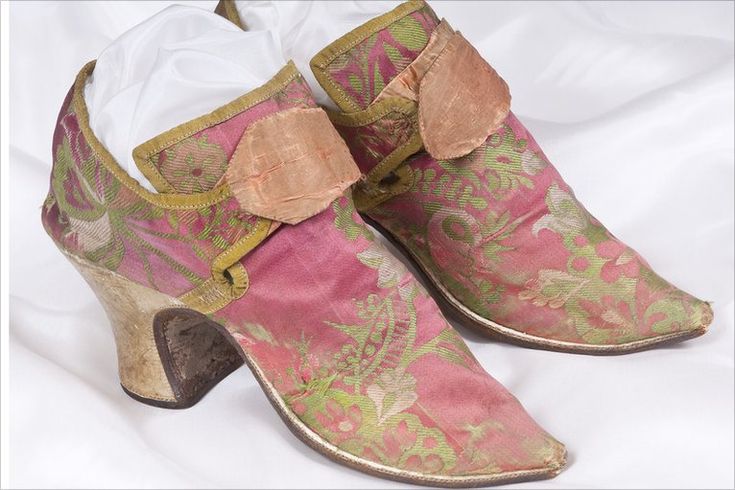
Shoes, 1720s-30s
A softer rose features on Jacapo’s breeches and jacket lining, and another fetching pair of shoes:.
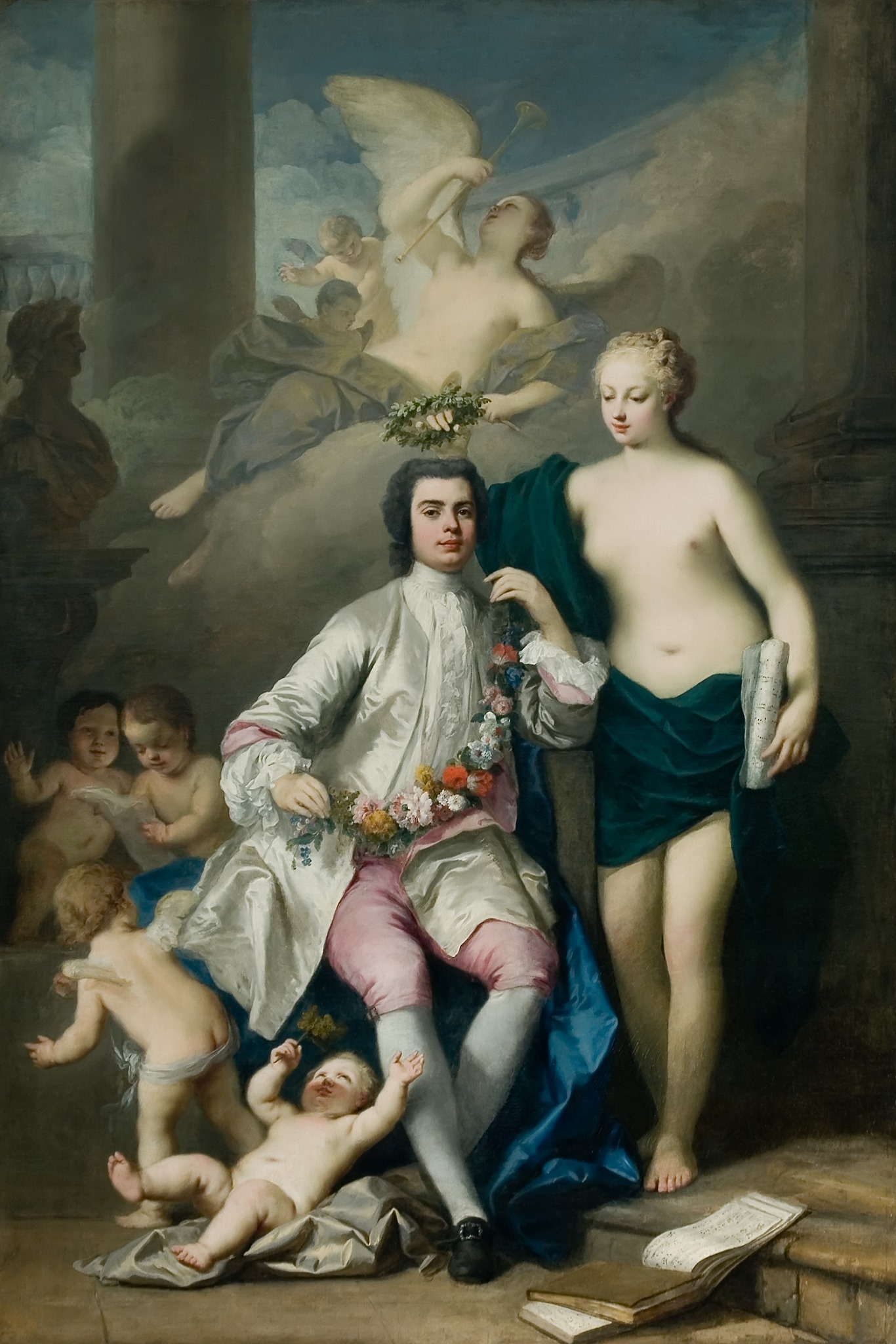
Jacopo Amigoni- English- Portrait of the singer Carlo Broschi named Farinelli 1734-35
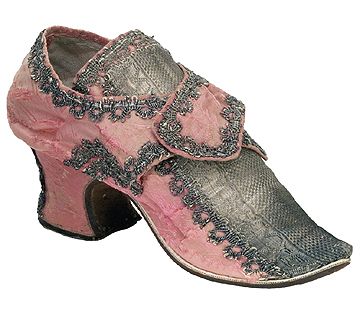
Pink silk shoes, English, c.1735-1750 Bata Shoe Museum
This portrait of Jane Clarke is a wonderful example of shot silks in the early 18th century. I wish I’d been able to find an extant item in a similar fabric!
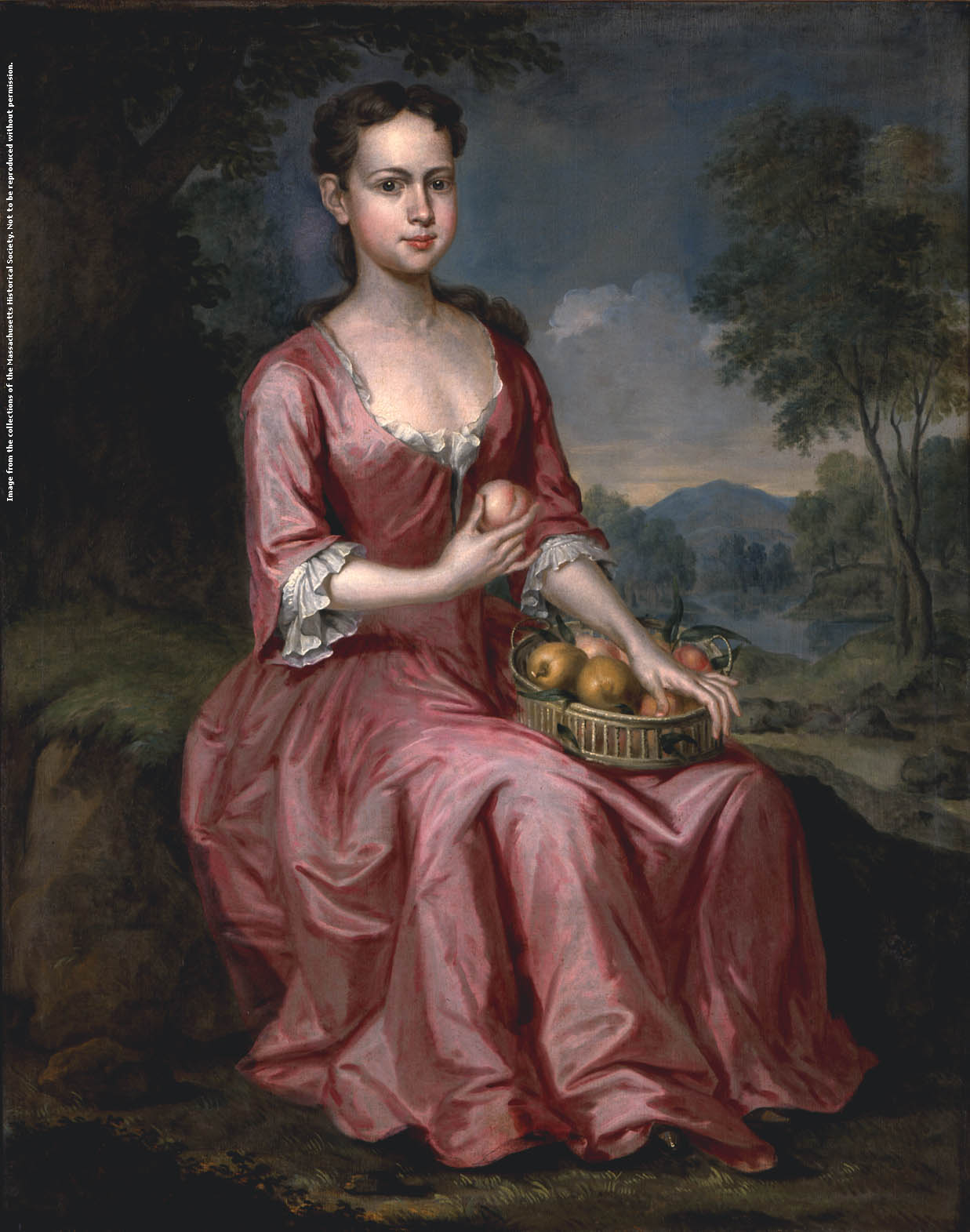
Jane Clark (Mrs. Ezekiel Lewis), John Smibert, 1732
Interestingly a very similar fabric is shown in another American portrait:
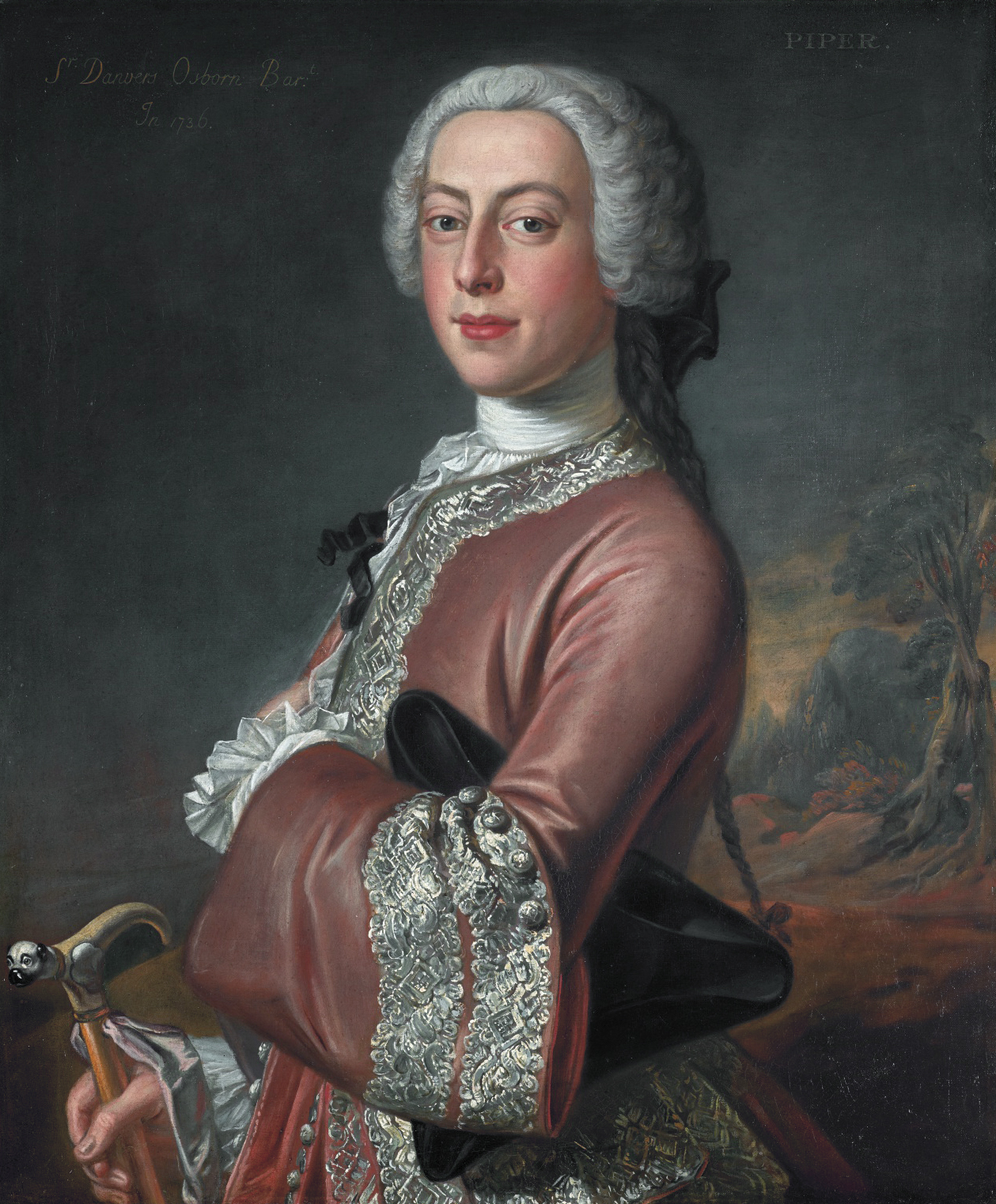
Danvers Osborn (1715-1753), Governor of New York, 1736
And on the lower tunic of the Ottoman Empire’s ambassador to Sweden, while two other members of his retinue are attired in salmon:
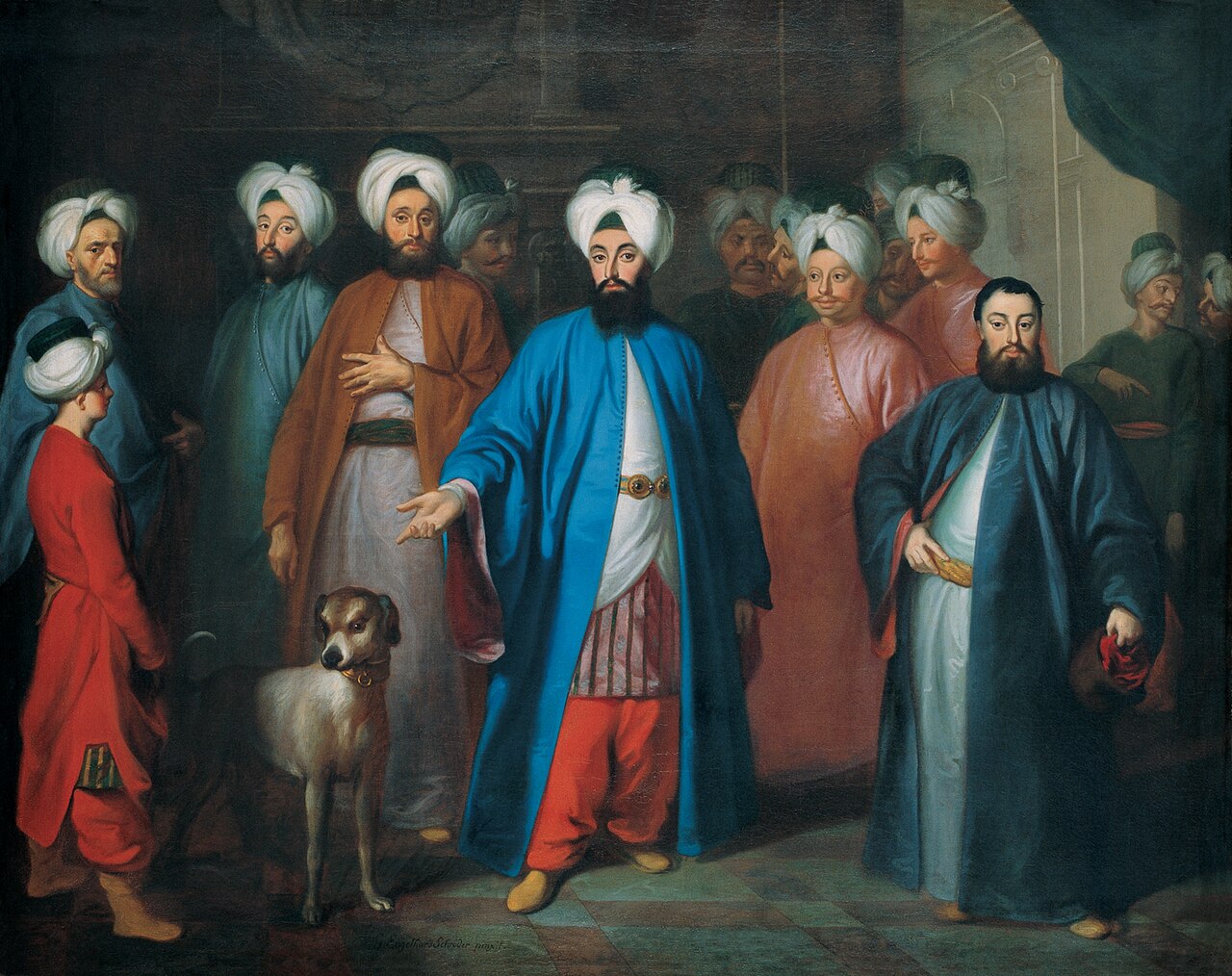
Georg Engelhard Schröder: Mehmed Said Efendi and his Retinue, 1735
The closest match I could find to those three portraits is this glorious casaquin. Just add in a dark blue cross thread for that shot effect:
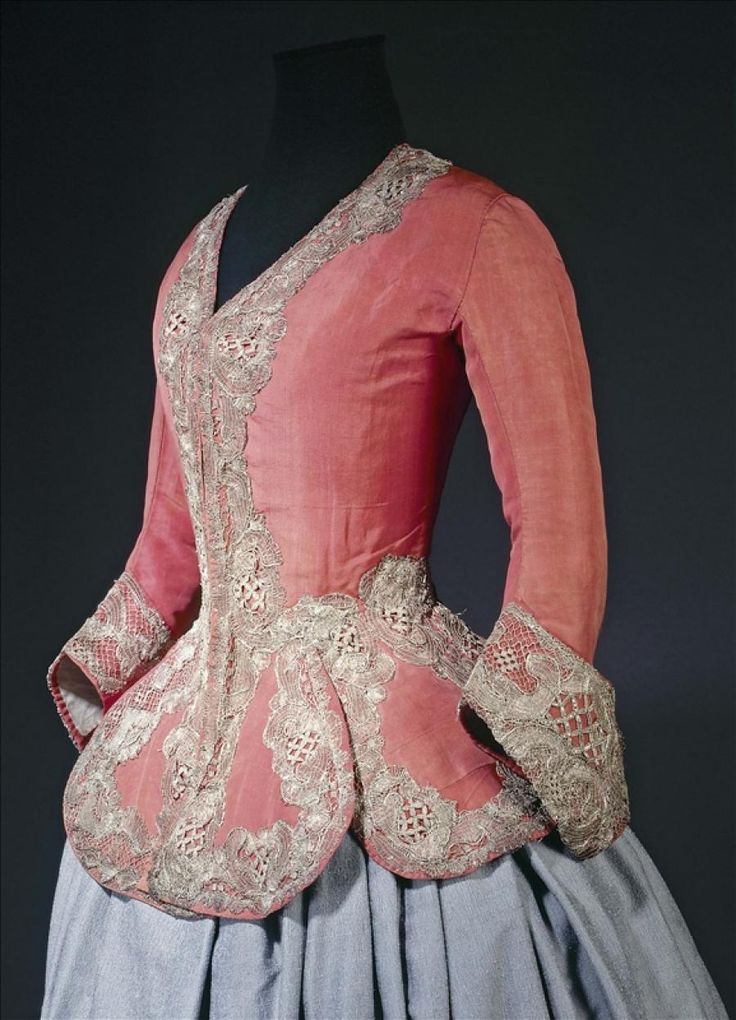
Casaquin. Date- ca. 1730 – 1740 Medium- Gros de Tours, orange silk, blue glazed linen lining, gilded silver lace, palaisgalliera.paris.fr
This unknown woman sports a very vivid coral jacket and skirt set, and as the waistcoat and jacket below show, the hue is not an exaggeration.
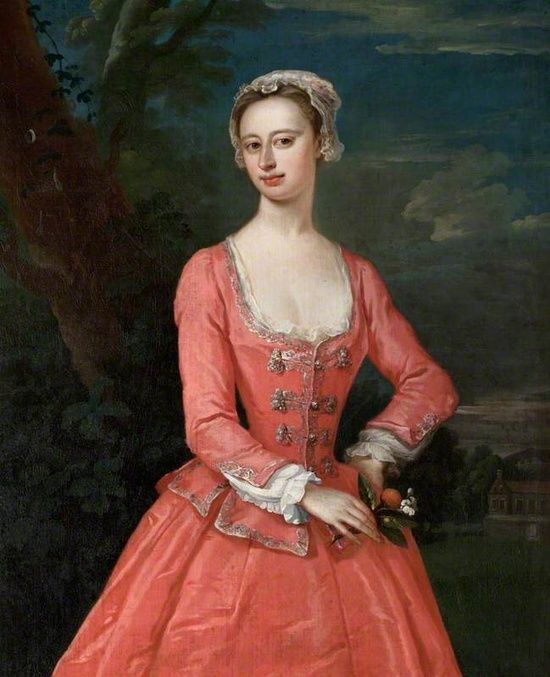
Portrait of a Lady, attr. to Jonathan Richardson the elder, c. 1730
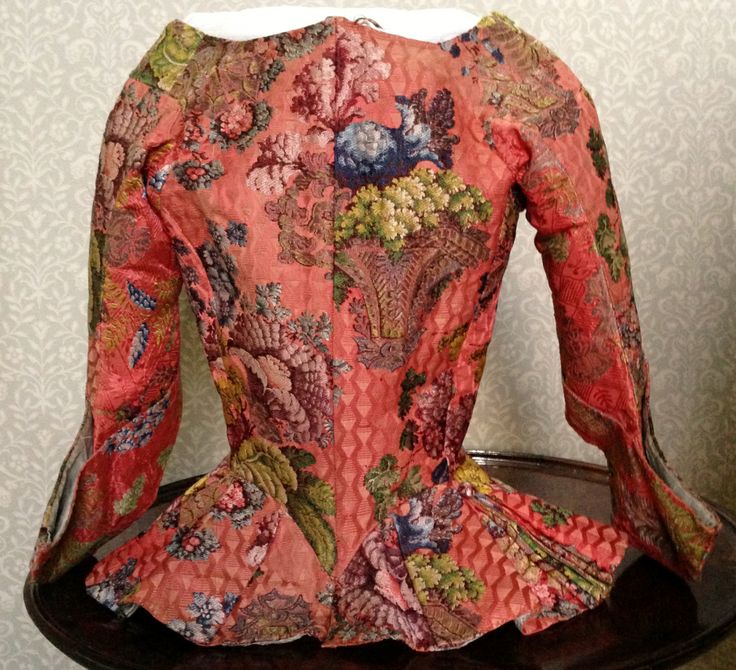
Jacket, 1736-40, Gorgeous Georgians at Berrington Hall 2014. From the Charles Paget Wade Collection stored at Berrington Hall
Adélaïde’s sister sports soft pink stripes in her beautiful gown, a match to the soft pink shoes below:
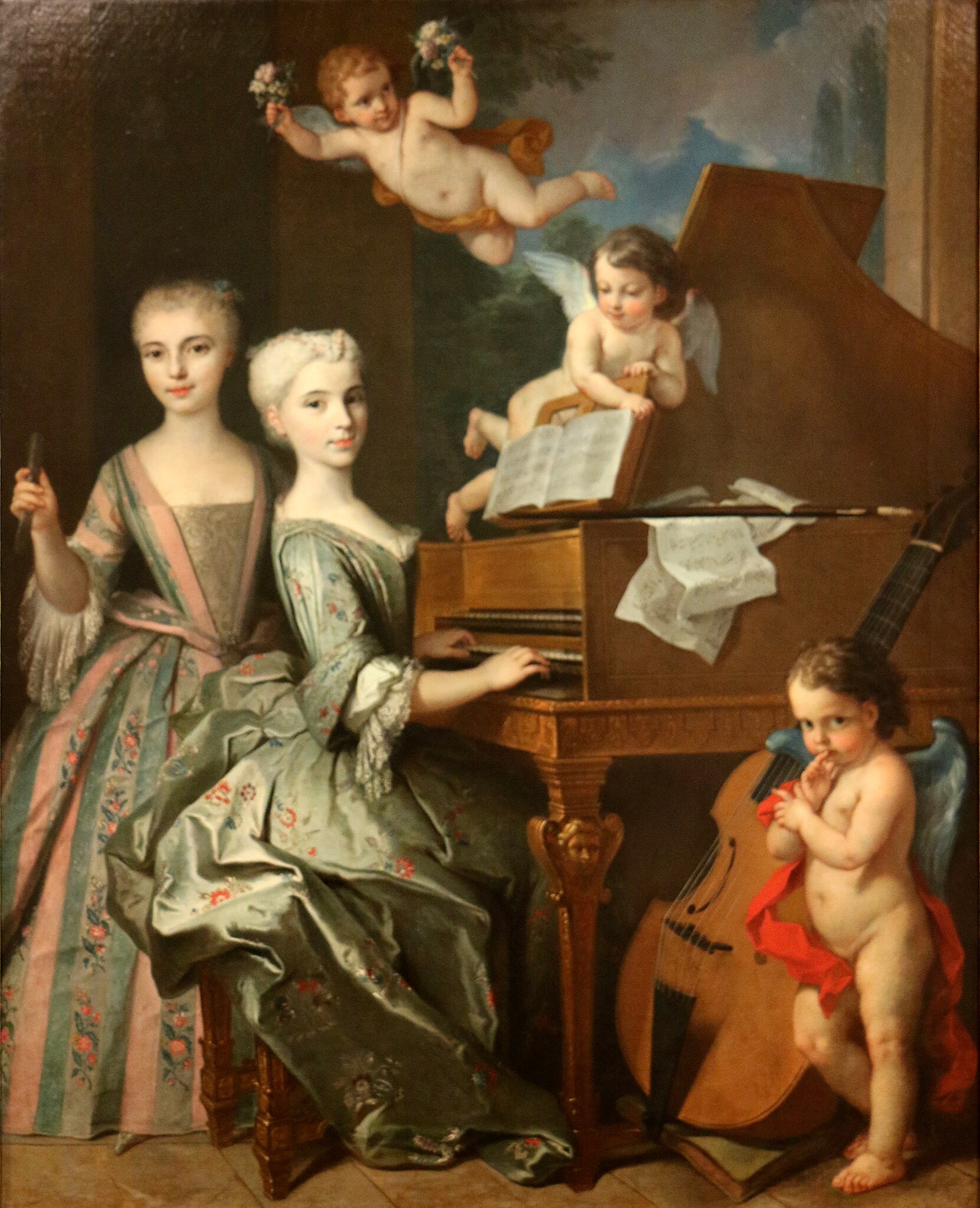
Claude Arnulphy (1697–1786), Adélaïde de Gueidan and her sister, 1735-4
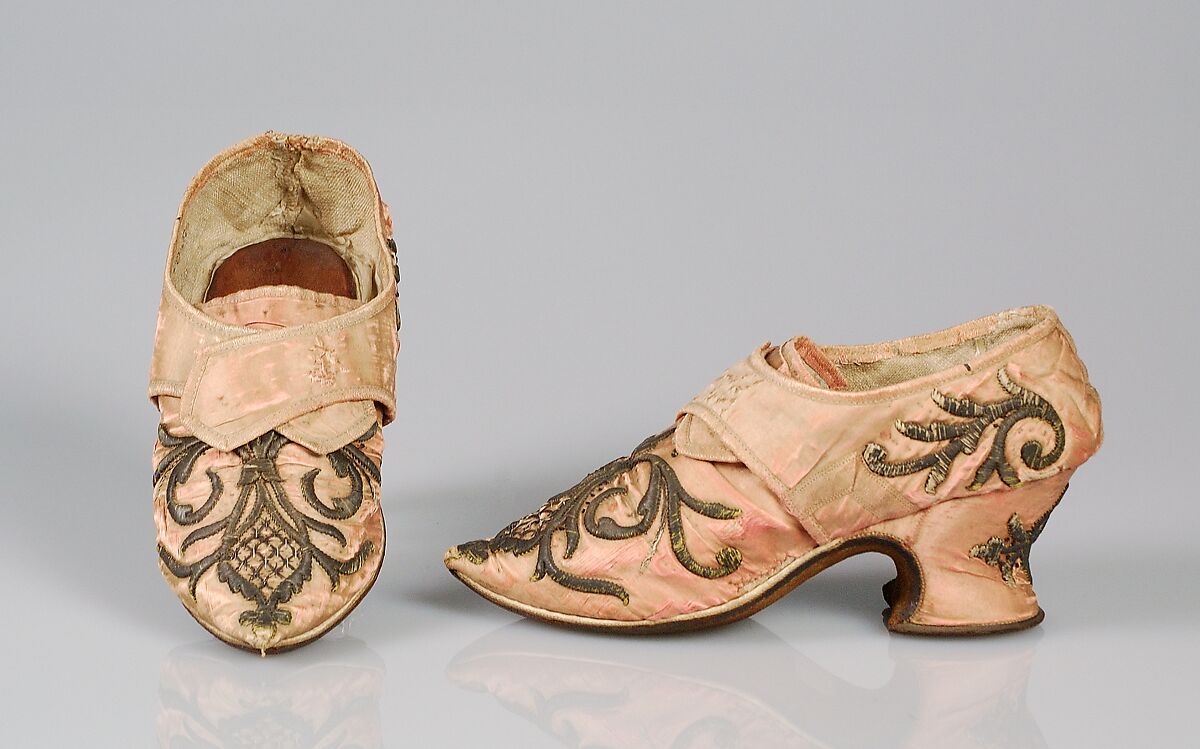
Shoes, 1710–49, British, Silk, metallic, Metropolitan Museum of Art, 2009.300.4131a, b
I love historical examples of self portraits by women artists, and here’s a delightful one featuring pink trimmings. Some of the same tints are picked up in the brocade jacket and the second portrait is a match to the pink silk below..
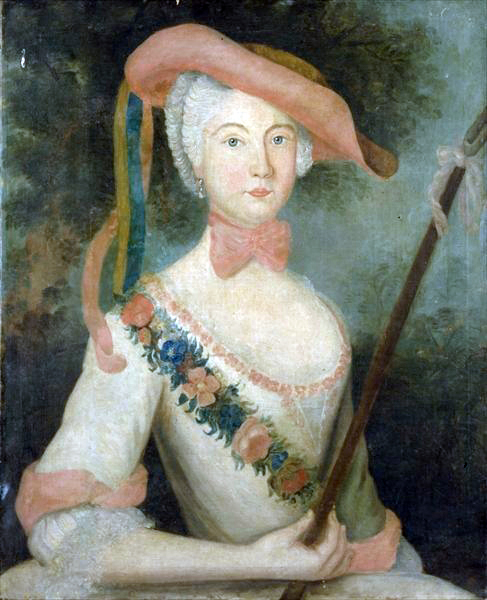
Elisabeth Christine of Brunswick-Wolfenbüttel-Bevern (1715–1797), Self-portrait as belle jardinière, 1739
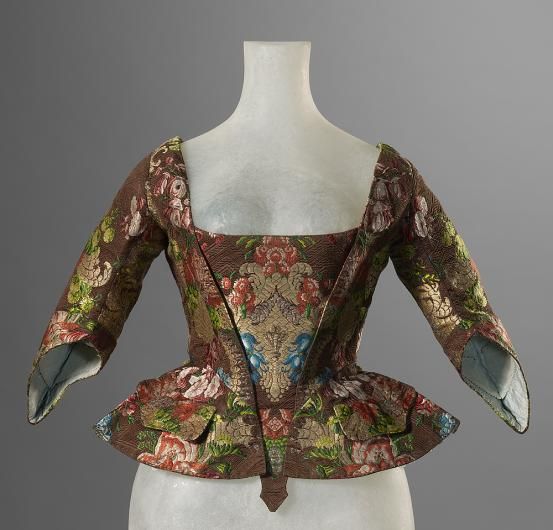
Jacket (Casaquin), c. 1730-1750; (fabric c. 1720- 1730, FRANCE silk and gilt brocade, National Gallery of Victoria, Melbourne, 1331-D4
She must have liked pink because the same colour show up on a more official portrait of her, and is picked up in the fabric
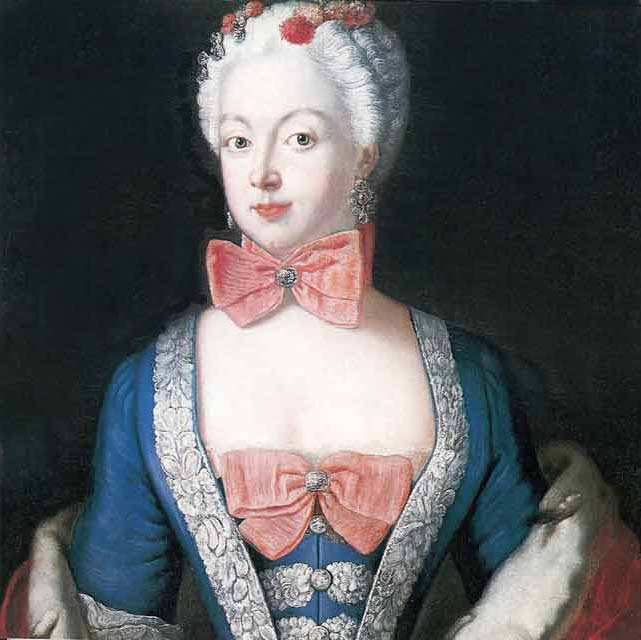
Antoine Pesne- Portrait of Elisabeth Christine von Braunschweig-Bevern, Prussian queen, 1739
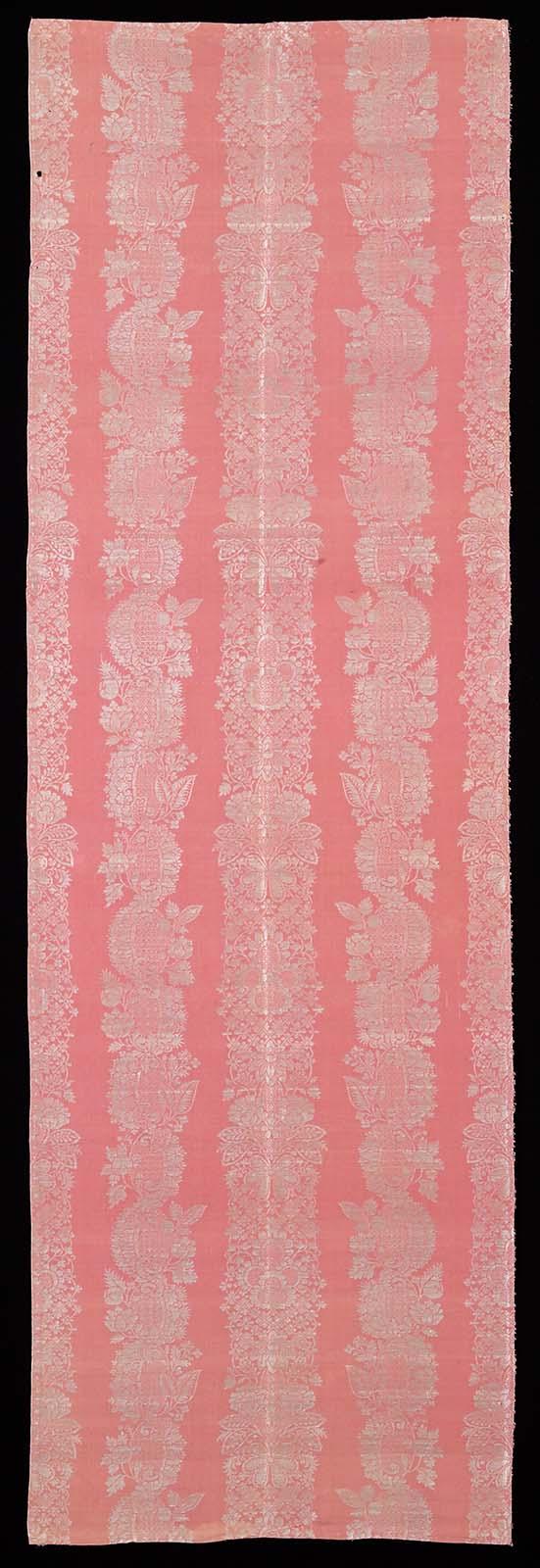
Length of Silk, ca 1730, England or the Netherlands, MFA Boston 2005.463
I’ve been very silent here on the blog lately. The world has been very overwhelming for the last few years, as has my personal life. While the first still terrifies me, the latter, thankfully, seems to be settling down.
Some things are changing because of what happened and is happening. Here’s what they are:
First, I’m going to be moving myself, The Dreamstress blog & Scroop Patterns off of Meta owned platforms as much as possible. Instead of FB and Instagram, I’ll be redirecting my energy (when I have it!) back to this blog. So hopefully that’s a good change!
Second, if you get the Scroop Patterns newsletter you would have heard about the changes to the free Frances Rump pattern. Because of bot attacks I’ve changes it from a free pattern to a ‘choose your own price’ pattern, which are less likely to be subject to attacks.
So now, you can choose any price from free ‘Students & Artists in Garrets’ to a supremely ridiculous price with the label ‘Look I just really love your patterns and want to pay an insane amount for this one’. Whichever you choose is fine!
One of the price options is ‘Treat the darling furball who supports the patternmaker by paying for a supersize pack of cat treats’.
So, what furball is this now that darling Miss Felicity has passed on?
Well, I’m not ready to have another full time cat, but I still love cats and miss having cuddles and something to take care of. So I’m fostering!
Over the holidays I fostered four super friendly kittens. They are, counting their heads from left to right: Mimi, Faith, Wendy and Murray (all girls).
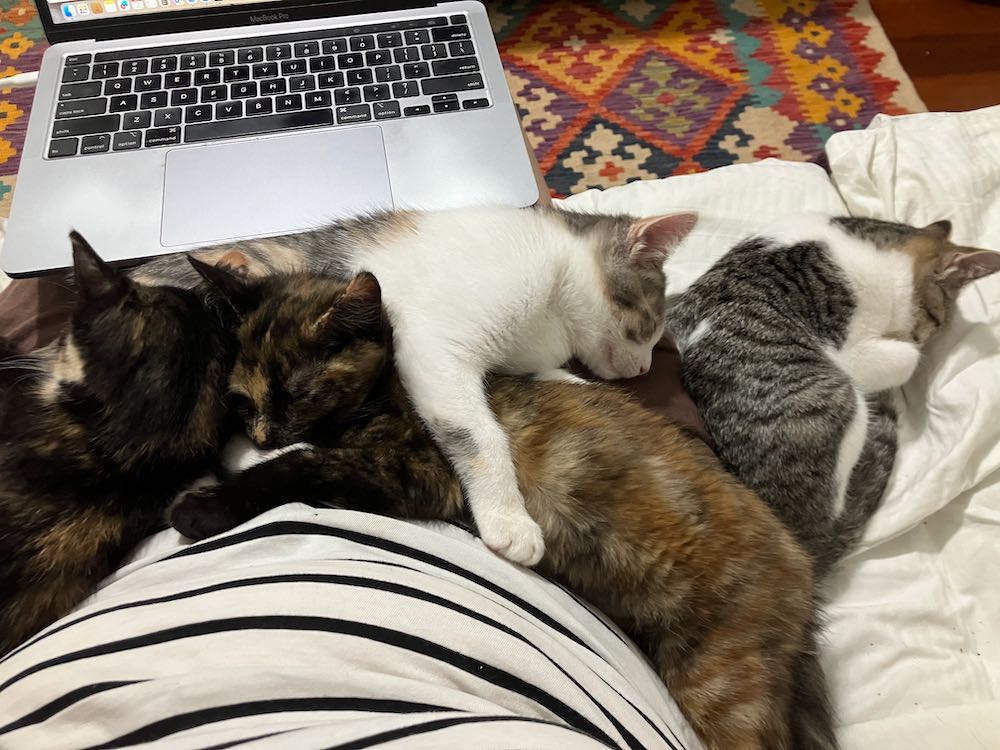
Wendy & Murray came first. They are sisters:
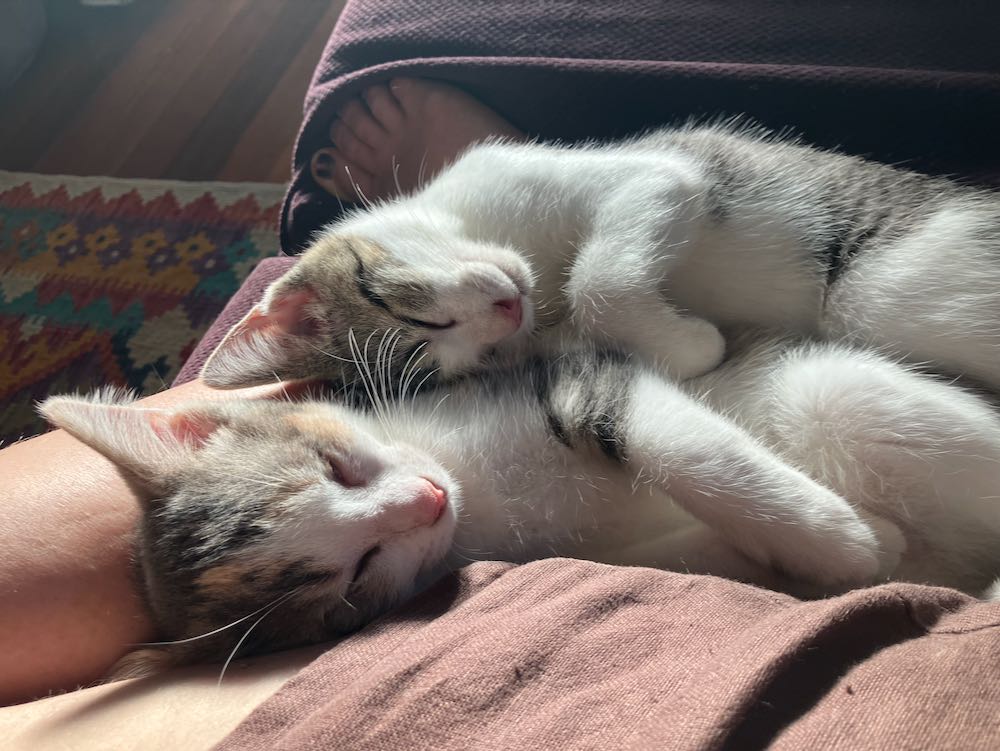
I taught them how to be good sewing cats:

Then they were joined by Mimi, the runt of her litter who stayed too small to spay long after her siblings were big enough to fix and adopt out:
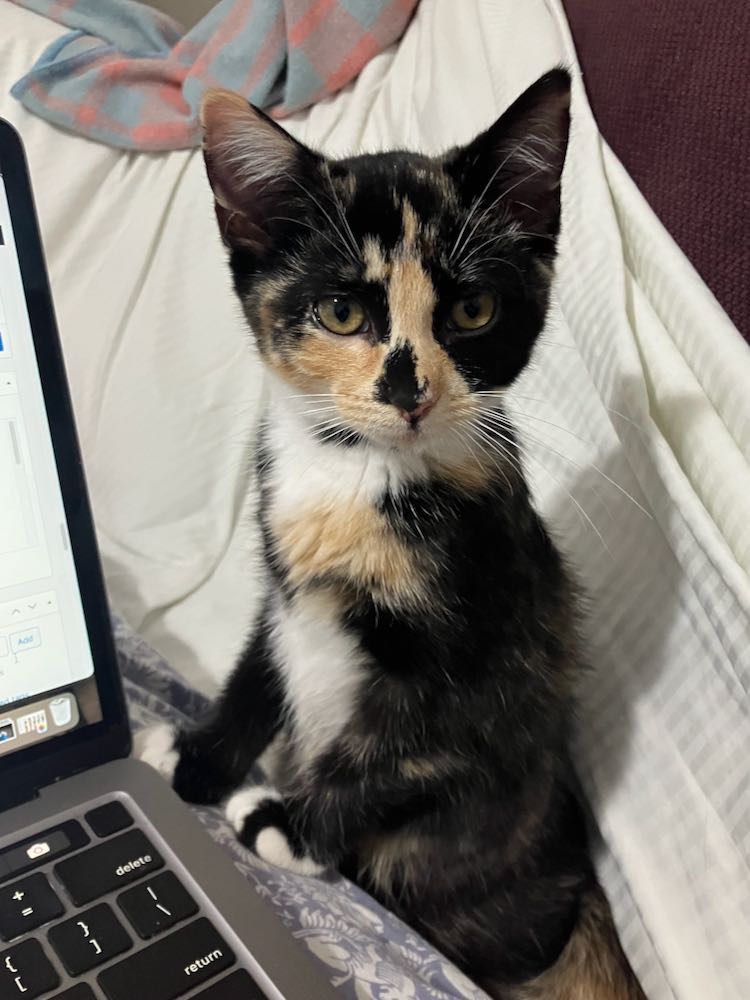
Mimi was well named. An operatic diva with cold little paws. She did not like to be left alone and had a VOICE to tell you her displeasure if you did.

Last to come was Faith, a kitten who got sick and lost a lot of weight after being spayed. She had to fostered while she recovered before she could be adopted out. Note her shaved tummy.
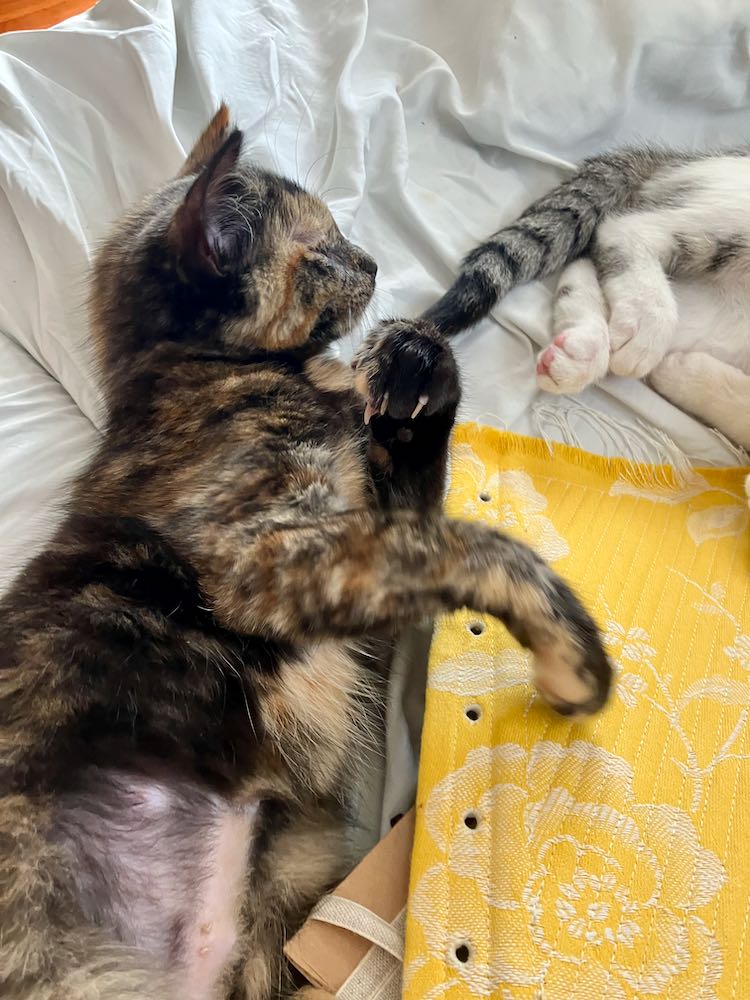
Faith was technically the naughtiest of the kittens but effectively the least naughty. She would lie on all the things she wasn’t supposed to (like my stays), but never scratched them. She figure out how to get into the food bag, but just sat there and enjoyed the fragrance. She worked her way out of the sleeping cage, but quietly curled up on the couch and did not wake us up by rampaging around the room, quite unlike the chaos Murray caused the night she broke out.

Faith was the first to figure out how to get on to the tops of the high dresser and mantlepiece, but she delicately wound her way through the photos and lamps, and didn’t touch the plants.

Once her foster siblings, on the other hand, managed the same feat they knocked down lamps and pictures, and tore all the leaves off my maidenhair fern!
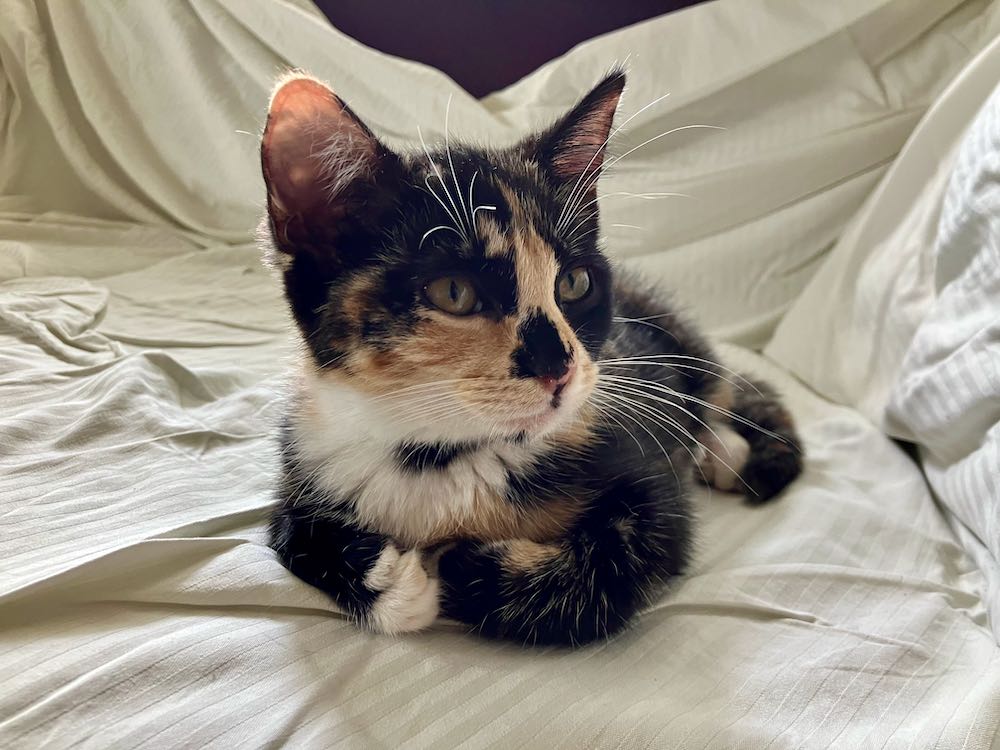
(and Mimi has zero remorse! Butter wouldn’t melt in her mouth!)

I had the kittens for over a month, and while it was delightful, I was glad when it was time for all the little rascals to go to other homes. What mayhem!
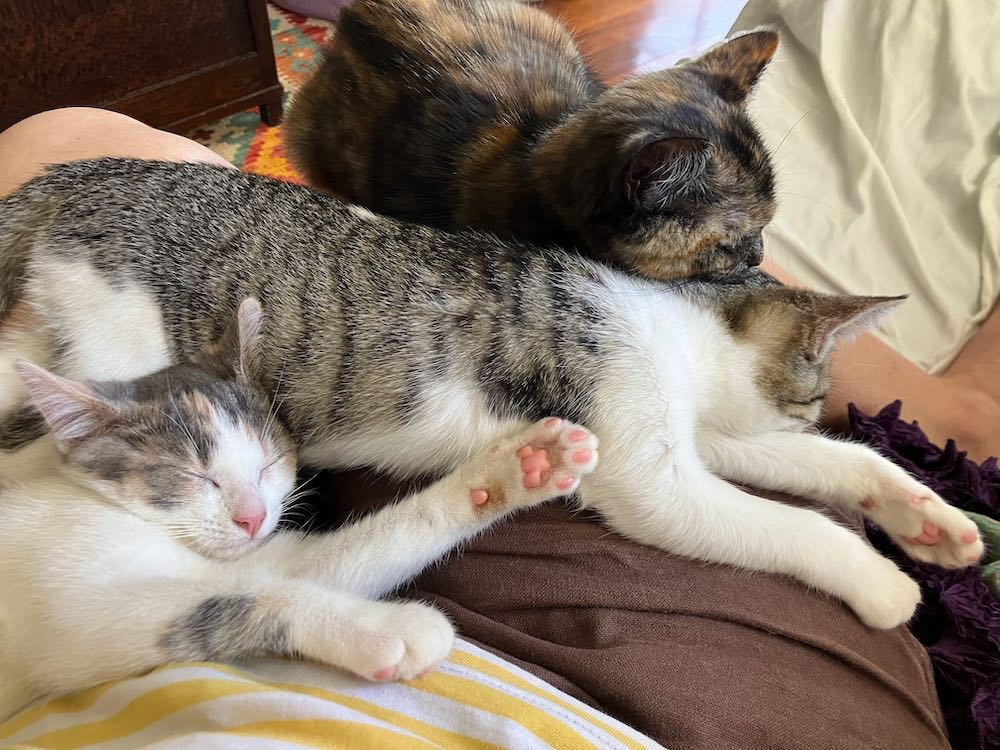
After the kittens I asked for a quiet adult cat, and I certainly got what I asked for!
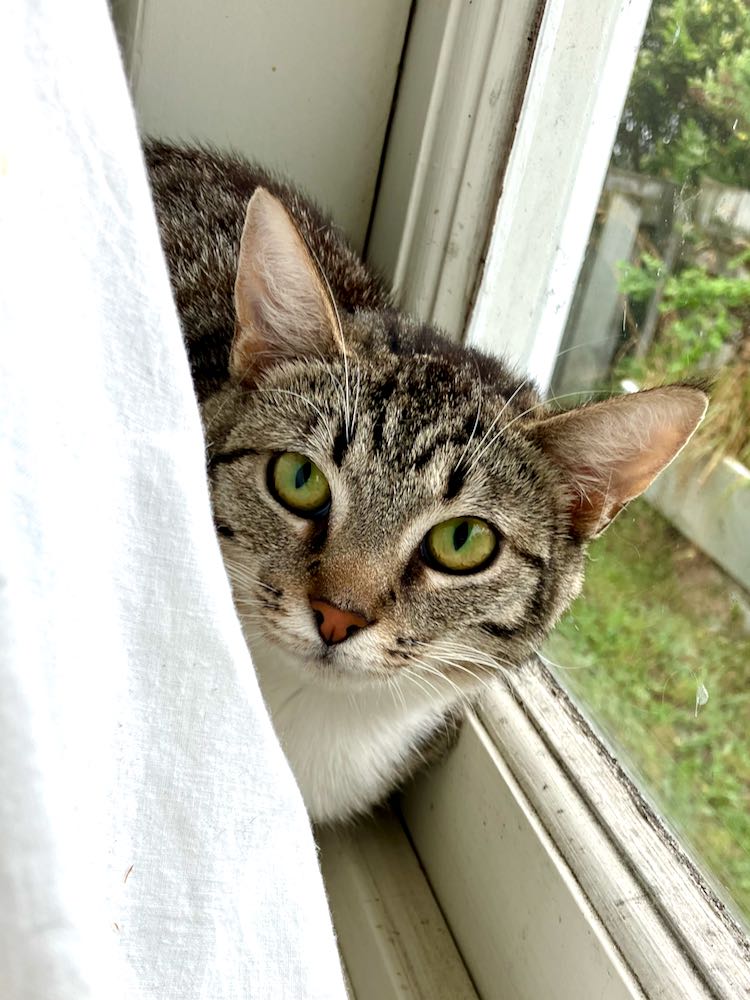
Miss Connie was a feral or abandoned mama cat. She was caught when pregnant, had her kittens and raised them to a good age. Once they were adopted out she came me to continue her education in trusting people.

It’s a slow process. She spent most of her first few weeks hiding under the couch all day. She’s only just in the last week agreed to be out in the same room as me during the day, and even then she’s only move about if she thinks I’m not watching. Still, progress is progress!
Connie was briefly joined by Hugo, a feral kitten who came from a colony with calicivirus and couldn’t be with other kittens until they were sure he wasn’t infectious.
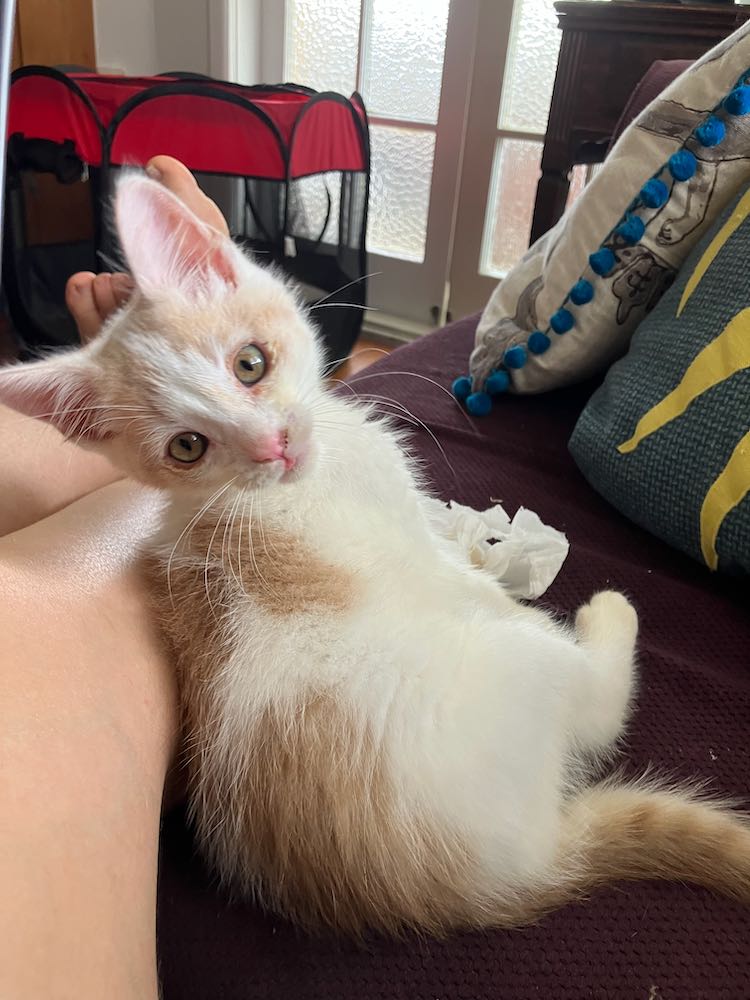
Before me Hugo had never been in a house. In three days he went from scared, timid kitten to entitled little snuggle bug.
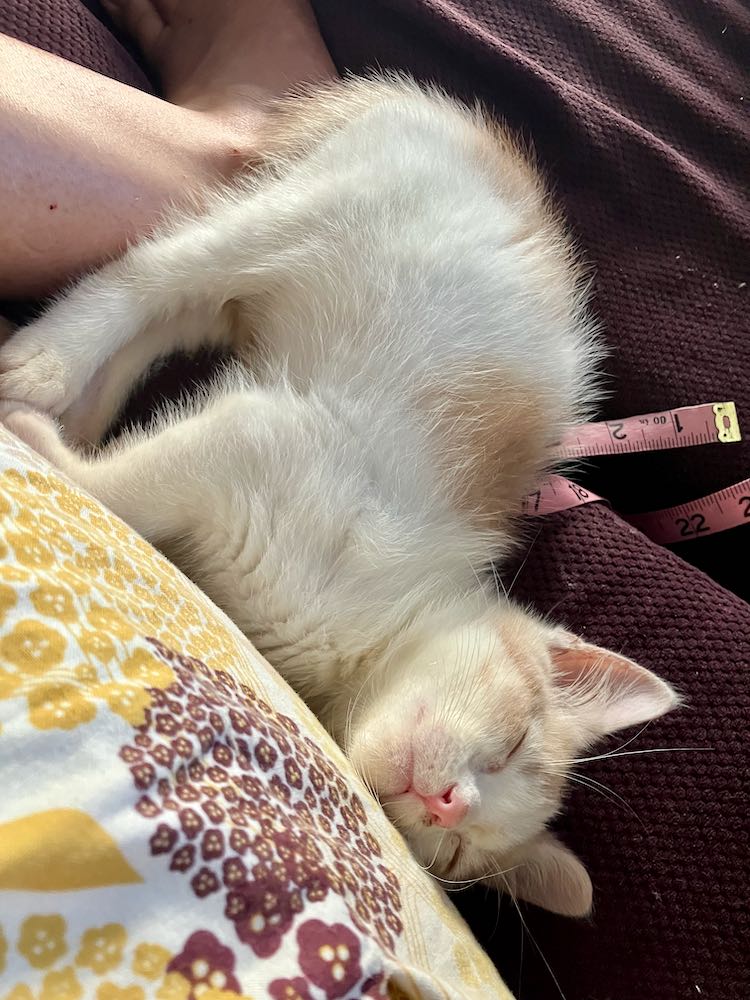
He expected at least three hours of interactive playtime and two hours of snuggling every day! And decided he was only willing to sleep on the finest of cushions.
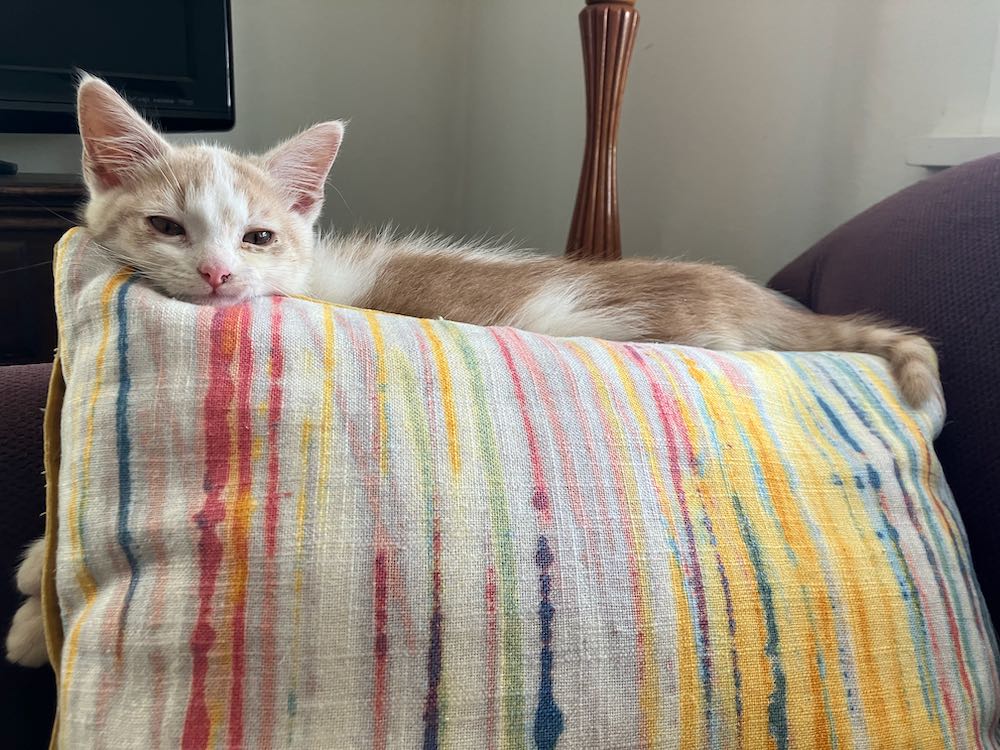
He was desperate for friends and absolutely adored Connie. She, for reasons you can see in the photo below, wasn’t so sure about him:

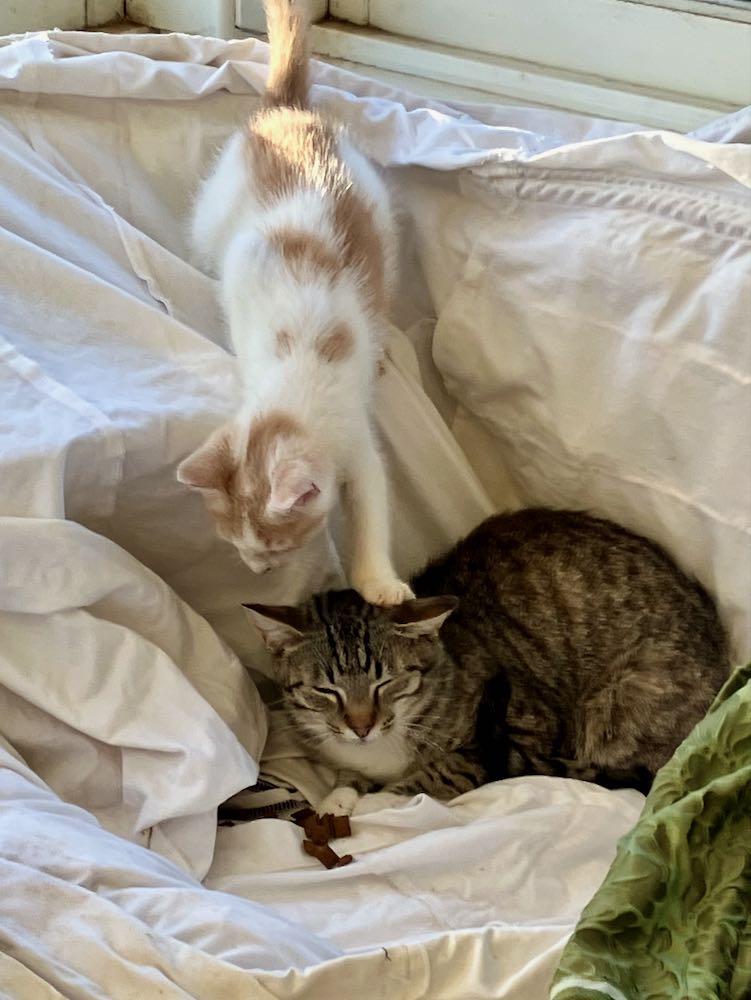
Once it was clear he was well Hugo went off to a foster where he could spend time with other kittens. Much Connie’s relief as she was tired of being tackled by an ecstatic kitten every time she ventured into the open. Now he has friends to tackle – and to tackle him!
So now it’s just me and Connie. And while I don’t get to snuggle her, the extra treats the sales of Frances Rumps fund are helpful for convincing her that humans are good.
In fact, I can hear her crunching on some temptations right now.